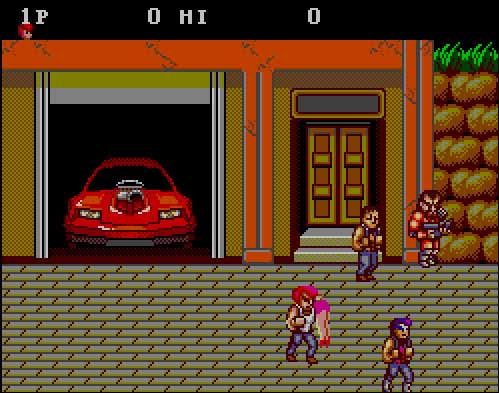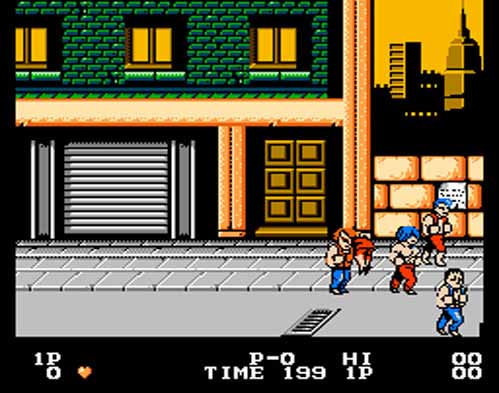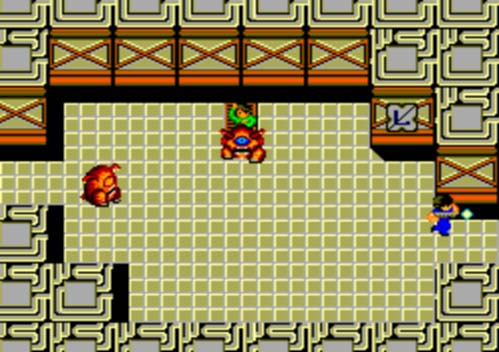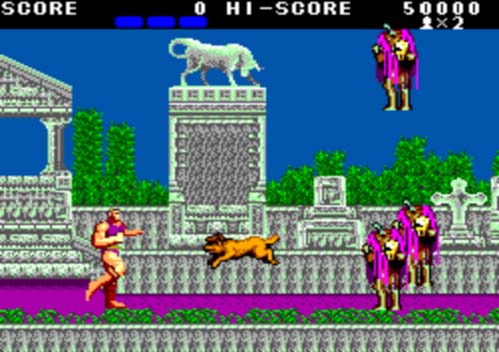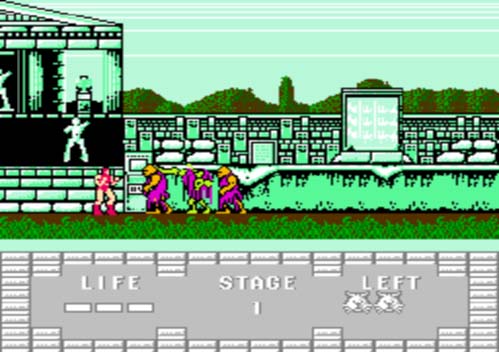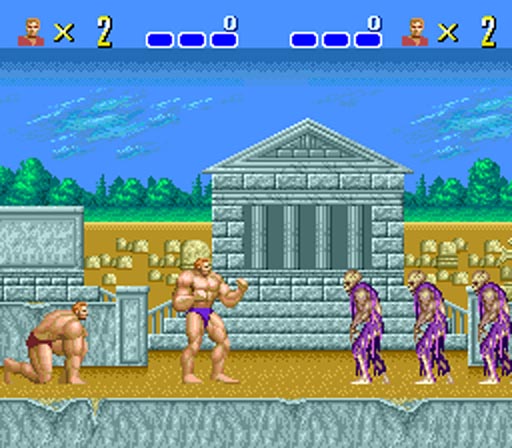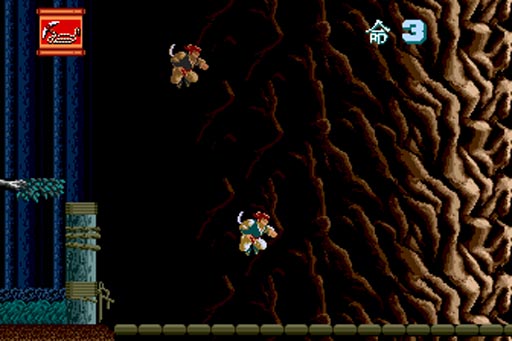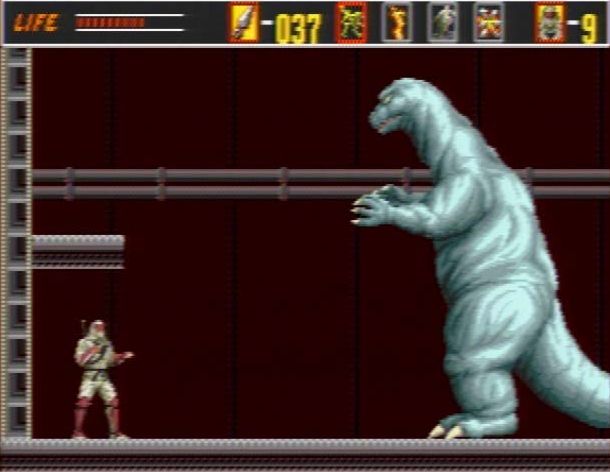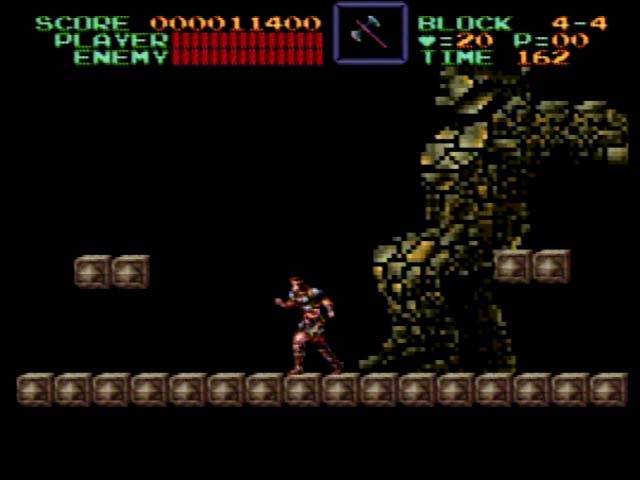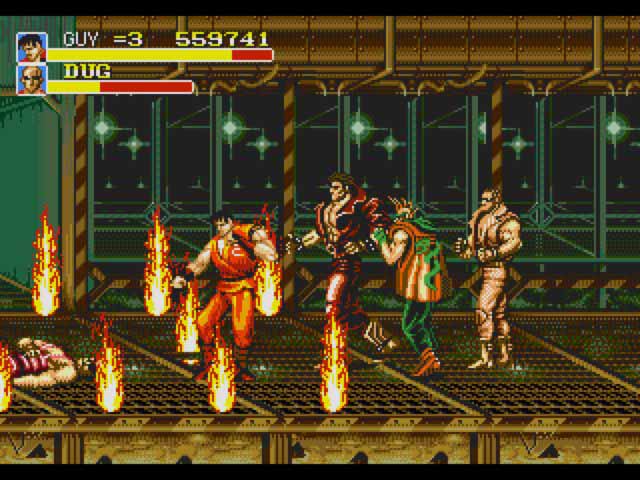Console History
2D Generations - 8-bit to 16-bit:


 ||
||  ||
|| 


Add-ons, CD-ROMS, FMV and early 3D gaming:
 ||
||  ||
||  ||
||  ||
|| 
3D Generations - 32-bit to 128-bit:


 ||
||  ||
|| 

 ||
||  ||
|| 
- 1. bias 3 a : bent, tendency b : an inclination of temperament or outlook; especially : a personal and sometimes unreasoned judgment.
Sega Master System vs Nintendo Entertainment System
| Lifespan: | 1986-1992 | |
|---|---|---|
| CPU: | 3.58 MHz Z80 | |
| Audio: | 4 Channels 3 | |
| Co-Processor: | VDP | |
| Resolutions: | 256x192, 256x224, 256x240 (PAL) 4 | |
| RAM: | 8KB | |
| Video RAM: | 16KB | |
| Color RAM: | 32 bytes5 | |
| Colors On Screen: | 32 (two 16-color palettes)6 |
|
| Color Palette: | 64 | |
| Sprite Max & Size: | 64 at 8x8, 8x16, 16x16, 16x327 |
|
| Sprites per Scanline: | 8 8 | |
| Storage: | Sega Card (32KB) Cartridge 1Mb - 4 Mbit |
 9 10
9 10
| Lifespan: | 1986-199211 |
|---|---|
| CPU: | 1.79 MHz 6502 |
| Audio: | 5 Channels 12 13 |
| Co-Processors: | PPU, pAPU14, MMC15 |
| Resolution: | 256x224 visible of 256x24016 |
| RAM: | 2KB |
| Video RAM: | 2KB |
| Colors On Screen: | 16 (four 4-color background palettes + four 4-color sprite palettes)17 |
| Color Palette: | 52 |
| Sprite Max & Size: | 64 at 8x8 and 8x16 |
| Sprites per Scanline: | 8 18 |
| Storage: | Cartridge 1 Mbit - 4 Mbit Average: 1 Mbit |
Hardware specifications for the 8-bit consoles (1982-1987) are relatively easy to read. The Sega Master System arguably trumped the Nintendo Entertainment System in most technical respects, aside from the base systems' audio capabilities. Both systems were also released nation wide in the United States in 1986.19 Yet technical superiority affects the market success of a console very little. Size and quality of a game console's library might be given lip service in comments and editorials, but games tend to play second fiddle to popularity and brand over the history of the game industry.
Third party developer (third party) support for the Sega Master System (SMS) was comparatively small due to the monopoly Nintendo designed for the Nintendo Entertainment System (NES). Licensing contracts for the NES prevented third parties from making the same game on other consoles for two years.20 This fact was exacerbated by Nintendo's publishing empire in Japan, where most of the world's game developers and publishers survived the "crash" of 1984. Nintendo's affinity for legal recourse locked most third parties into sitting on their Intellectual Property (IP) or rebranding and selling it to other console manufacturers.
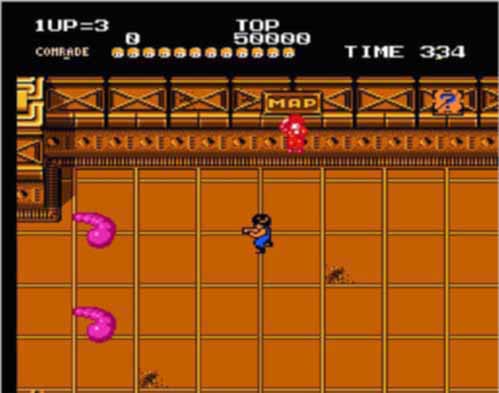 Nintendo's stringent publishing controls left them with less than ten third parties in 1986.21 While Nintendo was courting third party developers and establishing its dominance at retail in 198722, Sega was adapting its significantly larger arcade catalog to the SMS.23 As a result, the NES library only clearly surpassed its main rival console in quantity of quality titles after the 16-bit generation was in its stride in 1990.24
Nintendo's stringent publishing controls left them with less than ten third parties in 1986.21 While Nintendo was courting third party developers and establishing its dominance at retail in 198722, Sega was adapting its significantly larger arcade catalog to the SMS.23 As a result, the NES library only clearly surpassed its main rival console in quantity of quality titles after the 16-bit generation was in its stride in 1990.24
Sega's Master System is home to a number of exclusive titles, including the first console role playing games in the West. Phantasy Star and Miracle Warriors included innovative features such as animated 3D dungeons, five save anywhere save slots, female protagonists, diverse monster designs, and complex clue based puzzles. For every space ship shooter, "Mario" platformer or "Zelda" adventure game on the NES, the Master System had an exclusive with at least equal gameplay quality and better graphics. Yet the total US release list only added up to one hundred and fourteen titles, most of which were published, if not originally designed or recoded, by Sega themselves.
A controversial difference exists between companies like Sega and companies like Capcom, Nintendo, and Namco during these formative years of the game industry. Sega's focus on games throughout their time as a hardware manufacturer was focused on creating unique experiences and advancing the technology. Nearly all of Nintendo's mainline publishers, and Nintendo themselves, focused on creating popular game franchises. Exceptions to this rule exist on both sides, but the principle is dominant in the published software. What this means to the history of gaming is that a monumental battle occurred in game development theory immediately upon the arrival of Japan in the US game industry. Conceptually, the question these companies' games present is whether the consumer wanted unique experiences in high quantity and quality, or whether they wanted familiar experiences to be replicated. Game developers in this era, perhaps unconsciously, asked whether consumers wanted to try something new more frequently than they wanted to play the third, fourth or fifth iteration of essentially the same game.
In addition to exclusive unique games, a very notable peripheral was only released for the SMS, Liquid Crystal Display 3D glasses. These glasses plugged in to the secondary game card slot on the SMS, and synchronized opaque flashes on either eye with flashing character sprites on the television. The resulting effect produced a 3D effect far superior to red and blue card board glasses and is a technical marvel that is supposed to revolutionize television and movies in the new millennium.
A relatively short library includes Blade Eagle 3D, Maze Hunter 3D, Missile Defense 3D, Space Harrier 3D, Poseidon Wars 3D, Zaxxon 3D, and the Euro only release of Outrun 3D sum up the relatively small library of 3D games for the Master System. So unique were these glasses that Sega even included them as a pack in for the more expensive Master System console package. Notable as this peripheral was, what few consumers actually bought an SMS gravitated toward cheaper packages.
Despite these very notable facts, the Sega Master System was a total marketing failure for Sega in Japan and the United States. To its credit, the SMS actually dominated well into the mid 90's in Europe, Australia, New Zealand and Brazil, and revenue generated from these countries has caused a great deal of games to be produced. Many more Master System games were made for these markets that are actually compatible without modification with US Master Systems. Were there a sizeable retro-gaming market in the early 2000s, this too would be a notable fact about the Master System.
There are popular theories as to why the SMS was not a success in the United States. One very plausible reason is Nintendo's monopolistic licensing contracts with third parties. This left the SMS without popular third party titles available on a large enough scale to compete with the NES library. Another contributing factor was Sega's lack of a United States office at the time of the Master System's release. Sega sold the publishing and marketing rights to Tonka toys because Tonka had more resources to make the system a success. Unfortunately, the presentation by numerous sources is that Tonka sat on the Master System until their multi-year contract with Sega was up. This presentation is no doubt inaccurate to the reality of Nintendo's strangle hold on retailers from 1987 onward.
Facts state the case much more concisely. With relatively insignificant marketing, and the fact that Nintendo ensured that the console itself was not available on as many shelves as the NES, the Master System was actually doomed from the moment it landed on US shores. Well documented defects in the NES's quality control and design, which has caused up to 30% of systems shipped to stop playing games and all games to have noticeable glitching during scrolling scenes, were utterly overlooked by consumers.
The NES and SMS were Nintendo's and Sega's first entries in the video game console market in the United States. Nintendo and a group of less than ten third party developers helped to propel the NES to monumental success by 1988. Sega and a handful of other third parties supported the Master System with exclusive arcade and home-only game software, adding up to one hundred and fourteen titles. The Nintendo Entertainment System sold something around fifty million worldwide and saw seven hundred and sixty-one releases in the United States. Thirteen Million SMSs were sold worldwide from 1985-1998, and US support for the console was cut off around 1992.
In regard to what people were actually playing on each system, according to reviews online, over one hundred of the final US SMS library have been noted as having unique or highly polished gameplay, in such a way that they have received a recommendation from reviewers today. By comparison, roughly three hundred of the NES's final library of over seven hundred and sixty titles have been recommended for similar reasons. From 1986-1988, the SMS and NES had roughly the same number of titles which people have found worth mentioning. The majority of the NES's vastly larger library, and its lead in notable game titles, was gained after 1989, when the 16-bit era had already begun and the NES was the only mass market 8-bit platform.
- 1. Legacy Sega Consoles: Sega Master System, Sega of America (archive.org January 19, 2002).
- 2. Samuel N. Hart, A Brief History of Home Video Games: Side-by-side Comparison of the Sega Master System and Nintendo Entertainment System, Geek Comix (archive.org June 25, 2008).
- 3. 3 channel tone generator, white noise channel, mono Super Majik Spiral Crew's Guide to the Sega Master System (0.02) (smsc.txt) Basic Sound (Public Domain, SMSC, June 21, 1997, accessed March 11, 2010) available from http://emudocs.org/?page=Master%20System; internet.
- 4. Charles MacDonald, E-mail || Homepage, Sega Master System VDP documentation (msvdp.txt), 11.) Display timing (2002, accessed March 11, 2010) available from http://emudocs.org/?page=Master%20System; internet.
- 5. MacDonald, msvdp.txt, 5.) Color RAM.
- 6. Background patterns can use either palette, while sprite patterns can only use the second one. MacDonald, msvdp.txt, 5.) Color RAM.
- 7. 16x16 and 16x32 Sprites are only available when all sprites on screen are stretched, smsc.txt,
Register 81h.
- 8. msvdp.txt 10.) Sprites.
- 9. Hart, Side-by-side Comparison of the Sega Master System and Nintendo Entertainment System.
- 10. Nintendo of America, Systems: NES Specifications (archive.org June 15, 2001).
- 11. NES was test marketed in 500 to 600 retail stores in New York during Christmas, 1985, David Sheff, Game Over: How Nintendo Zapped an American Industry, Captured Your Dollars, and Enslaved Your Children (New York: Random House, 1993), 169.
- 12. 2 Square Waves, 1 Triangle, 1 White Noise, 1 Delta Modulation Channel for samples, Uses the CPU. Brad Taylor, The NES sound channel guide 1.8 (nessound.txt), Introduction (July 27, 2000, accessed March 11, 2010) available from http://emudocs.org/?page=NES; internet.
- 13. Brad Taylor, NTSC delta modulation channel documentation 2nd release (DMC.txt), (February 19, 2003, accessed July 17, 2011) available from http://nesdev.parodius.com/dmc.txt; internet.
- 14. "virtual" sound unit inside CPU
- 15. Yoshi, Nintendo Entertainment System Documentation 2.0 (nestech.txt), 2. Acronyms (accessed March 11, 2010) available from http://emudocs.org/?page=NES; internet.
- 16. Martin Korth, Everynes - Nocash NES Specs (everynes.txt) PPU Dimensions & Timings (2004, accessed March 11, 2010) available from http://emudocs.org/?page=NES; internet.
- 17. everynes.txt PPU Palettes.
- 18. everynes.txt PPU Sprites.
- 19. Steven L. Kent, The Ultimate History of Video Games (New York: Three Rivers Press, 2001), 303.
- 20. Sheff, Game Over, 215.
- 21. Kent, The Ultimate History of Video Games, 307.
- 22. Sheff, Game Over, 171.
- 23. Kent, The Ultimate History of Video Games, 304.
- 24. Notable Games: 1985-1990, http://www.gamepilgrimage.com.
TurboGrafx-16
| Lifespan: | 1989-1993 |
|---|---|
| CPU: | 7.16 MHz 8-bit HuC6280 4 |
| Audio: | 6 Channels (Uses CPU) 5 |
| Co-Processors: | 3.58 Mhz PSG 6 Video Processor: 16-bit HuC6270 7 Color Processor: HuC6260 8 |
| Resolutions: | 256x256 || 320x256 9 |
| RAM: | 8 KB |
| Video RAM: | 64 KB |
| Colors On Screen: | 480 (60-90 Average, ~128 Max in games) 10 |
| Color Palette: | 512 ( 32 Palettes of 16 colors each) 11 |
| Sprite Max & Size: | 64 at 16x16, 16x32, 16x64, 32x16, 32x32, and 32x64 pixels 12 |
| Sprites per Scanline: | 16 13 |
| Background Planes: | 1 Layer (Dynamic Tiles and Sprites were used to create up to four scrolling layers) |
| Storage: | HuCard 16Mbit (2.5MB), Average 4 Mbit CD-ROM |
Just as the battle between the 8-bit Nintendo Entertainment System and Sega Master System was looking one-sided the first of many electronics giants entered the fray. The NEC manufactured TurboGrafx-16 (TG16) was released in 1989 in the US and displayed impressive visual quality, audio and effects compared to its 8-bit predecessors and its 16-bit competition. NEC's game console boasts relatively high amounts of colors on screen at once, software scaling in games like Afterburner (Japan),14 and multi-level backgrounds (parallax) in space ship shooters. Despite the TurboGrafx's 8-bit central processor these effects demonstrate a significant edge in horsepower over the later released, fully 16-bit, Super Nintendo. The relative color limitation for Sega's Genesis should also lend NEC proper respect for designing a state of the art game console. As a result, game magazines in 1989 painted a picture of the TG16 quickly becoming a major contender in the US game console wars.15 16
The PC-Engine was released one year before the Megadrive (Sega Genesis) in Japan. By 1989 the PC-Engine, renamed TurboGrafx-16, had over one hundred software titles published and ready to be localized for the US market.17 Nintendo's monopoly, and subsequent restrictive licensing contract with third party developers, contributed greatly to hindering the localization of most of these software titles.18 As Nintendo's licensing contract for the NES is understood, no game made for the NES could be made for another console within two years. So, popular NES software such as the original Megaman, released December of 1987, could not be released on the TurboGrafx until 1990. Nintendo Entertainment System owners would meanwhile be playing the third iteration of Megaman. Game developers already had to decide whether to spend their time and money producing a game for an unproven console. For the initial years following their release, developers for the TG16 and Sega Genesis could only release arcade adaptations, new games or completely reprogrammed and rebranded versions of NES software.
Nintendo owned at least ninety percent of the game console and software sales in Japan and the United States in 1989, so NES software took priority for third party developers.19 This left the TurboGrafx with a relatively small selection of titles from NEC and Hudson Soft. Probably to compensate for bad press, NEC took a marketing stance of only releasing the "best of the best" PC-Engine titles locally. Nevertheless, the final TG16 library pales in comparison to what was available for the PC-Engine in Japan.20 It is no coincidence that many of the games that were never localized were superior versions of popular NES software. The opinion, however, of journalist created history claims that what few PC-Engine titles were localized by NEC, Hudson, and a handful of third parties were not "fun," or popular enough, to make the console successful in the United States.21 22
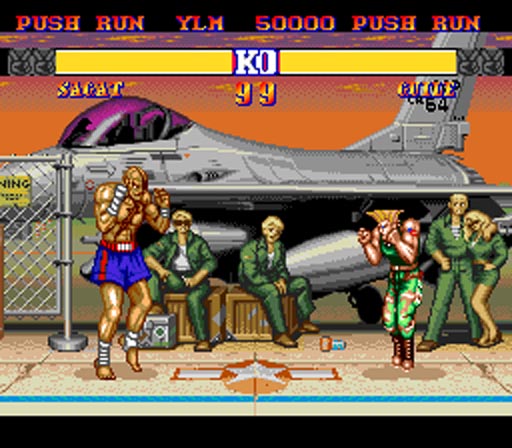 Sega and Nintendo managed to publish and license enough games during the previous generation's formative years to be roughly equal in library by the end of 1989. During these years, Nintendo spent more time courting developers than making games. As a result, from 1990 to 1992, no console could compete with the flood of software releases on the NES.23 So non-Nintendo hardware should be viewed as a separate market during this time. In 1989 and 1990 the TG16 saw roughly the same amount of quality software releases as the Sega Genesis and Master System combined.24
Sega and Nintendo managed to publish and license enough games during the previous generation's formative years to be roughly equal in library by the end of 1989. During these years, Nintendo spent more time courting developers than making games. As a result, from 1990 to 1992, no console could compete with the flood of software releases on the NES.23 So non-Nintendo hardware should be viewed as a separate market during this time. In 1989 and 1990 the TG16 saw roughly the same amount of quality software releases as the Sega Genesis and Master System combined.24
NEC also took the cutting edge title in 1990 by releasing the CD-ROM add-on for the TurboGrafx. The Turbo CD added an additional library of over one hundred CD-ROM titles, including excellent Role Playing Games (RPGs). NEC promised an affordable price for their CD-ROM add-on, but the list price for the Turbo CD ended up being $399. Much the same as Sega's Master System, NEC's add-on was relatively difficult to find on store shelves. Insufficient localization effort for the add-on's pre-released Japanese library is another oft cited flaw of NEC's marketing strategy. So select, according to popular game magazines, was the Turbo CD localizations that the game media accuses NEC for single handedly killing the add-on.
The TurboGrafx and the Turbo CD-ROM were left with fewer titles, by a ratio of at least 7:1, in comparison to the Sega Genesis alone by the end of the 16-bit generation. In 1989 and 1990, however, the TG16 saw roughly the same amount of quality software releases as the Sega Genesis and Master System combined.25 By Spring of 1991 the TurboGrafx library had grown to the point that the main thrust of NEC's advertising campaign stated "It's easy to beat the competition when you've got them outnumbered."26 It was in fact only after the Super Nintendo and Sega CD were on the market in 1992 that the TG16's library dramatically lagged in software releases of notable quality.
According to inconsistent online sources, the TurboGrafx-16 only sold around 2.5 Million units in the US by 1993, a significant failure when compared to Sega's Genesis that sold over 20 Million in the US by 1995. The TG16's marketability effectively began and ended in 1990 when the Genesis proved to be the relative marketing success and Sega devoted all of its resources to toppling Nintendo's gaming empire. Yet the TG16-CD combination saw one more significant push in 1992, when Turbo Technologies Inc (TTI) launched the Turbo DUO. The tale of TTI's two systems in one will be discussed in greater detail in its own section.
- 1. Jonathan J. Burtenshaw, ClassicGaming.com's Museum NEC TurboGrafx-16 (TG16) - 1989-1993 (archive.org February 1, 2008)
- 2. TurboGrafx-16/Duo FAQ - By John Yu, Last revised: 05/25/95 (archive.org May 14, 2007)
- 3. emulationzone.org Turbo-Grafx/PC-Engine Emulation Sections (archive.org June 15, 2008)
- 4. GAMESX.com Forums, Console Mods, RobIvy64 (e-mail) "TG-16/PCE overclocking success!" (archive.org May 1, 2008)
- 5. 6 Waveforms, 1 Frequency Modulated Channel leaves 4 Waveforms, 1 Waveform Channel can become White Noise, all channels can be programmed for sound samples. Paul Clifford (e-mail), PC Engine Programmable Sound Generator (psg.txt) (accessed February 18, 2010) available from http://www.plasma.demon.co.uk/pcengine/; internet.
- 6. Clifford, psg.txt $0802 - Fine frequency adjust
- 7. Emanuel Schleussinger, PC-Engine Video Display Controller Documentation (vdcdox.txt), (February 1998, accessed March 19, 2010) available from http://www.zophar.net/documents/pce.html; internet.
- 8. Paul Clifford (e-mail), PC Engine Video Colour Encoder (vce.txt)(accessed February 18, 2010) available from http://www.plasma.demon.co.uk/pcengine/; internet.
- 9. Typically only 216 horizontal lines are visible and are either 256 or 320 pixels wide, Schleussinger, (vdcdox.txt) 5. The Sprites in the VRAM.
- 10. Sixteen 15 Color palettes for the background, sixteen 15 Color Palettes for Sprites, Clifford, (vce.txt).
- 11. Clifford, (vce.txt).
- 12. Nimai Malle (e-mail), pce_doc Video Sprites (accessed March 20, 2010) available from http://emudocs.org/?page=PC%20Engine
- 13. Actual limit may be 8 due to 16 pixel wide sprites being aligned as 32 pixel sprites, Malle, pce_doc Video Sprites
- 14. Scaling is the technical term for a two dimensional object that moves closer or further away from the screen in an animated sequence. The term does not included animated sprite transitions to simulate the same effect.
- 15. "16-bit Sizzler," Electronic Gaming Monthly, May 1989, 30.
- 16. Steve Massey, "The Cutting Edge: The TurboGrafx-16," Gamepro, July 1989, 11.
- 17. Steve Harris, "Turbo to Increase Library of Titles," Electronic Gaming Monthly, December 1989, 50.
- 18. David Sheff, Game Over: How Nintendo Zapped an American Industry, Captured Your Dollars, and Enslaved Your Children (New York: Random House, 1993), 215.
- 19. Steven L. Kent, The Ultimate History of Video Games (New York: Three Rivers Press, 2001), 423.
- 20. "Slasher Quan," "So, You Want to Buy A 16-Bit System...", Gamepro's 16BIT Video Gaming, February 1992, 7.
- 21. Sheff, Game Over, 351.
- 22. Kent, The Ultimate History of Video Games, 449-450.
- 23. Tom R. Halfhill, "Software Shakeout," Game Players, January 1991, 4.
- 24. Notable Games: 1989-1990, http://www.gamepilgrimage.com.
- 25. Notable Games: 1989-1990, http://www.gamepilgrimage.com.
- 26. Electronic Gaming Monthly, March 1991, 28-29.
Sega Genesis vs Super Nintendo
| Lifespan: | 1989-1996 |
|---|---|
| CPU: | 7.67 MHz 16/32-bit 680005 |
| Co-Processors: | 3.58 MHz Z80 (Audio/SMS): Can write to 68000's Work RAM6 Can access cartridge's ROM data7 Texas Instruments 76489 (PSG Audio): 4 Channels 8 Yamaha 2612 (FM Audio):9 6 Channels: One 8-bit Stereo Digital Audio Channel (DAC) replaces one FM channel 10 10 Audio Channels total Output Frequency: 52 kHz |
| Video Processing: | VDP Master System Compatibility 11 Hardware Shadow and Lighting 12 Direct Memory Access (DMA): Transfer Rate: 7.2 KB per 1/60th second13 |
| Resolutions: | 256x224, 320x224, 320x448 14 |
| Work RAM: | 64 KB |
| Video RAM: | 64 KB |
| Audio RAM: | 8KB |
| Color RAM: | 72 Bytes 15 |
| VSRAM: | 40 Bytes 16 |
| Colors On Screen: | 61 (30-75 in game, average 50) 17 18 |
| Color Palette: | 512 |
| Sprite Max & Sizes: | 80 sprites at 320x224 64 sprites at 256x22419 Sprite Sizes: 8x8, 8x16, 8x24, 8x32 16x8, 16x16, 16x24, 16x32 24x8, 24x16, 24x24, 24x32 32x8, 32x16, 32x24, 32x32 20 |
| Sprites per Scanline: | 20 at 320x224, 16 at 256x224 21 |
| Background Planes: | 2 layers with 16 colors per 8x8 pixel tile22 VDP handles scrolling as single planes, independently scrolling 8 line rows, and independently scrolling lines.23 Each 8 line row can can be displayed over or under others. 24 |
| Storage: | Cartridge up to 32 Mbit (4 MByte) Bankswitch method allows more than 32 Mbit of storage.25 |
| Lifespan: | 1991-1997 |
|---|---|
| CPU: | 3.58 MHz 16-bit 65c816 31 6502 Compatibility (unused) |
| Co-Processors: | SPC700 (Sound CPU) S-DSP (Sound Generator) 8 Digital Audio Channels Independent Stereo Panning (per channel)32 Filters for audio smoothing and echo 33 Compressed audio decoding 34 Output Frequency: 32 kHz |
| Video Processing: | PPU 1 PPU 2 (On the same chip) 35 Mozaic/Pixelation DMA Transfer Rate: 5.72 KB per 1/60th second shared by 8 Channels 36 HDMA Used for per line updates 37 |
| Resolution: | 256x224, 256x448, 512x224, 512x448 38 |
| Work RAM: | 128 KB |
| Video RAM: | 64 KB |
| Audio RAM: | 64 KB |
| Sprite RAM: | 512 + 32 bytes 39 |
| Color RAM: | 512 Bytes 40 |
| Colors On Screen: | 240-256 41 42 (90-150 average in game) |
| Color Palette: | 32,768 |
| Sprite Max & Size: | 128 sprites at: 8x8 & 16x16, 8x8 & 32x32, 8x8 & 64x64, 16x16 & 32x32, 16x16 & 64x64, 32x32 & 64x64, 16x32 & 32x64, 16x32 & 32x32 43 |
| Sprites per Scanline: | 32, 34 8x8 tiles, 256 sprite pixels per line 44 |
| Background Planes: | Eight Modes Numbered 0 - 7 4 (96-colors, 24 per background, 3/tile) 3 (two 120-colors, one 24-colors) 2 (120-colors) 2 (240-colors, 120-colors) 2 (240-colors, 24-colors) 2 (120-colors, 24-colors, interlaced) 1 (120-colors, interlaced) 1 (255-color, scaled, rotated, etc) 45 |
| Storage: | Cartridge up to 32 Mbit (4 MByte) • Tales of Phantasia (1995) (48 Mbit) • Star Ocean (1996) (48 Mbit) Average: 8 Mbit ('91), 16-32 Mbit ('92-'97) |
It is demonstrable that the SNES could actually display 2-3 times the colors on screen, while the Genesis could display 2-3 times the sprites and independently scrolling 2D planes. The SNES also could scale and rotate one 256 color plane, which could be made to look like large objects such as Bowser in Super Mario World or the Bomber in the first level of Contra IV. Alternately, games on the Genesis typically ran with less slowdown, featured faster scrolling levels, "tilted" sprites and backgrounds, and featured more custom special effects like scaling backgrounds and fully polygonal gameplay without any cart loaded processors. The Genesis' software effects are best seen in Contra Hard Corp, Castlevania Bloodlines, Batman and Robin, Ranger X, Sonic 3D Blast's bonus levels, LHX Attack Chopper, and Red Zone, for starters.
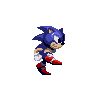 Much as was the case with the NES library, the Super Nintendo saw full fledged releases for several years after the Genesis was discontinued. Combined with the SNES's dominance in Japan, the system consequently had a larger worldwide library by the end of its cycle. Because Square and Enix released their titles exclusively, the SNES has a greater number of RPGs available for it in the US.
Much as was the case with the NES library, the Super Nintendo saw full fledged releases for several years after the Genesis was discontinued. Combined with the SNES's dominance in Japan, the system consequently had a larger worldwide library by the end of its cycle. Because Square and Enix released their titles exclusively, the SNES has a greater number of RPGs available for it in the US.
 Despite superficial marketing tactics, the battle between NEC, Sega and Nintendo produced a wide variety of exclusive and critically acclaimed games for each platform. The Genesis has the largest library, and eventually gained the most third party support, of any Sega console. The Genesis' action genre is packed with arcade ports and unique home offerings like the Shinobi and Streets of Rage series. Yet the Genesis was also home to exclusive Sega RPGs like Sword of Vermillion, Phantasy Star 1-4, Shining in the Darkness, and Shining Force 1+2, amongst other notable series like Super Hydlide, Ys, and Dungeons & Dragons. Lunar the Silver Star, Lunar Eternal Blue and Vay, along with other Working Design’s localization efforts of Game Art’s games, were also released on the Sega CD.
Despite superficial marketing tactics, the battle between NEC, Sega and Nintendo produced a wide variety of exclusive and critically acclaimed games for each platform. The Genesis has the largest library, and eventually gained the most third party support, of any Sega console. The Genesis' action genre is packed with arcade ports and unique home offerings like the Shinobi and Streets of Rage series. Yet the Genesis was also home to exclusive Sega RPGs like Sword of Vermillion, Phantasy Star 1-4, Shining in the Darkness, and Shining Force 1+2, amongst other notable series like Super Hydlide, Ys, and Dungeons & Dragons. Lunar the Silver Star, Lunar Eternal Blue and Vay, along with other Working Design’s localization efforts of Game Art’s games, were also released on the Sega CD.
Regrettably, popular history uses the same measuring stick for all success stories. Sales is what most ill advised people look to in order to validate or invalidate their purchase decisions and sales is what the media is biased towards. The Genesis outsold the SNES in the US overall up until its discontinuation in 1995. The SNES managed to more than catch up in the two years before the Nintendo 64 took hold. The SNES clearly won out in sales worldwide and software sales in every region.
The truly important thing is that the war between the two companies produced some of the best games to ever be made. The game player that has only owned one system to the exclusion of the other has definitely lost out. What is worse is that in the new millenium the entire industry is bent toward anti-competative corporations. The preference for Mega-Corporations and Mega-Publishers are reflected by the media's excessively positive portrayal of the Super Nintendo.
- 1. Sam Pettus, "SegaBase Volume 3 - Megadrive / Genesis 'Sega MK-1601'," (January 23, 2007, accessed March 31, 2010) available from http://www.eidolons-inn.net/ (archive.org November 7, 2007).
- 2. Samuel N. Hart, A Brief History of Home Video Games: Sega Genesis, Geek Comix (archive.org June 16, 2008).
- 3. Legacy Sega Consoles: Sega Genesis, Sega of America (archive.org December 8, 2002).
- 4. PC Vs Console - Console Specs (4th Generation), (archive.org March 15, 2008).
- 5. Up to 32-bit processes internally, 16-bit data bus, Programer's Reference Manual M68000PM/AD Rev.1.
- 6. Are we sure MD Z80 can't write to M68K RAM? NCS does it....
- 7. Sega Genesis Manual.
- 8. 3 tone generators and 1 white noise, "Nemesis," GENESIS Technical Overview 1.00, (accessed April 1, 2010), 119.
- 9. Frequency Modulation is synthesized audio like PSG but considerably more complex.
- 10. Must be timed correctly in software to allow 5 FM Channels to play with digital audio (Street Fighter II:CE plays multiple digital audio channels simultaneously), "Nemesis," GENESIS Technical Overview 1.00, 92.
- 11. Charles MacDonald, E-mail || Homepage, Sega Genesis VDP documentation Version 1.5f (genvdp.txt) $01 - Mode Set Register No. 2, (August 10, 2000, accessed March 11, 2010), available from http://emudocs.org/?page=Genesis; internet.
- 12. MacDonald, genvdp.txt, 16.) Shadow / Hilight mode.
- 13. Speed at which data in RAM can be transferred to VRAM,"Nemesis," GENESIS Technical Overview 1.00, 45.
- 14. Interlaced double resolution mode, used in Sonic 2 splitscreen 2-player.
- 15. 64x9 bits, MacDonald, genvdp.txt, 9.) CRAM.
- 16. Vertical scroll RAM, 40x10 bits, MacDonald, genvdp.txt, 10.) VSRAM.
- 17. four 15-color palettes plus one background color
- 18. Direct 9-bit RGB (512 colors) available at half horizontal resolution, 160x224 or 128x224 visible, "Oerg866," "Nemesis" and "Chilly Willy," "Direct Color Demo using DMA," SpritesMind.net, accessed March 1, 2013, http://gendev.spritesmind.net/forum/viewtopic.php?t=1203.
- 19. MacDonald, genvdp.txt, 15.) Sprites
- 20. "Nemesis," GENESIS Technical Overview 1.00, 13.
- 21. MacDonald, genvdp.txt, Sprite Drawing Limitations.
- 22. Each tile shares colors from four 15 color palettes between the background and sprite layers, MacDonald, genvdp.txt, $0B - Mode Set Register No. 3.
- 23. MacDonald, genvdp.txt, $0B - Mode Set Register No. 3.
- 24. Hardware function of the VDP, MacDonald, genvdp.txt, 14.) Priority.
- 25.
"THE BANKSWITCHING MECHANISM",
SSFII GENESIS TECHNICAL INFORMATION. - 26. Samuel N. Hart, A Brief History of Home Video Games: Super Nintendo Entertainment System, Geek Comix (archive.org February 7, 2008).
- 27. Nintendo - Super NES - Detailed Specs, Nintendo of America (archive.org June 27, 2001).
- 28. PC Vs Console - Console Specs (4th Generation), (archive.org March 15, 2008).
- 29. Usenet, Rec.Games.Video, Ralph Barbagallo, SNES Hardware (January 19, 1992, accessed April 2, 2010) available from http://groups.google.com; internet.
- 30. Super NES Programming/SNES Specs, (October 29, 2007, archive.org June 14, 2008) available from http://en.wikibooks.org/wiki/Super_NES_Programming/SNES_Specs.
- 31. 1.56 MHz or 2.68 MHz in some software, Hardware.txt, available from http://www.mit.edu/afs/athena/activity/p/peckers/Programs/snes9x/solaris..., 65c816
- 32. SPC-700 Programming Information.
- 33. Anomie's S-DSP Doc version WIP (e-mail) (apudsp.txt), (October 13, 2005, accessed April 8, 2010).
- 34. "Ledi" and "Peekin", Super Famicomm Sound Manual NOA-SFX-04/15/90 (sfsound.txt), (October 15, 2001, accessed April 9, 2010), available from http://www.emudocs.org/?page=Super%20NES.
- 35. PPU is is called a single processor in all other documentation, Kevin Neviksti, SNES memory map and MAD-1 chip information (SNES_MemMap.txt), (accessed April 23, 2010) available from http://gatchan.net/uploads/Consoles/SNES/Flashcard/SNES_MemMap.txt.
- 36. 2.68MB divided by 8 (channels) divided by / 60 (frames per second), DMA occurs during VBLANK, Super NES Programming/SNES Specs, Direct memory access unit.
- 37. Uses DMA channels, Hardware.txt, H-DMA
- 38. 448 and 478 line modes are interlaced, Qwertie, Combined Registers Document (combined.txt), Screen mode/video select register [SETINI] (accessed on April 8, 2010).
- 39. Super NES Programming/SNES Specs, Video RAM.
- 40. Each color uses 2 bytes, David Piepgrass, Qwertie's SNES Documentation Plus DMA Revision 6 (2.1), Color Palettes, (1998, accessed April 5, 2010) available from http://emudocs.org (archive.org July 12, 2007).
- 41. eight 15 color background palettes, eight 15 color sprite palettes in most common graphic modes,
Charles MacDonald, E-mail || Homepage, SNES hardware notes (snestech.txt), CGRAM, (September 17, 2003, accessed March 11, 2010), available from http://www.emudocs.org/?page=Super%20NES - 42. 2048 Colors are technically possible using Direct Color Mode, Hardware.txt, Direct Colour Mode.
- 43. snestech.txt, Sprites
- 44. Super NES Programming/SNES Specs, Maximum onscreen objects (sprites).
- 45. 4 backgrounds limits colors per tile (8x8 pixels) to 3-colors whereas other modes are 15-colors per tile, adapted from Qwertie's SNES Documentation, Register $2105: Screen mode register (1b/W).
1989-1990: Competing with Speculation
 Summer 1989, before NEC and Sega launched their 16-bit consoles, "Shooter" meant flying an advanced space craft against an evil armada and Nintendo, which owned ninety percent of the worldwide video game market, signified "video game."1 Before Fall, NEC focused its audience on the technical prowess of its newly dubbed TurboGrafx-16 and the merits of "16-bit gaming."2 NEC was not alone in advertising the generational leap, Sega also focused on a single characteristic turned marketing term for its new console, "16-bit."3 Undaunted, Nintendo Power, a magazine owned and operated by Nintendo, continued as it had for more than a year promoting Nintendo Entertainment System and then Gameboy portable games. Video game magazine start-ups Electronic Gaming Monthly (EGM) and Gamepro, however, mutually thrived on rumors and speculation about new hardware. In the same issues that extolled, for the first time, the soon-to-be released Genesis and TG16, both magazines devoted equal space to a "super" system from Nintendo.4 5 This represents an unprecedented public relations campaign for a game console that barely existed as a prototype.
Summer 1989, before NEC and Sega launched their 16-bit consoles, "Shooter" meant flying an advanced space craft against an evil armada and Nintendo, which owned ninety percent of the worldwide video game market, signified "video game."1 Before Fall, NEC focused its audience on the technical prowess of its newly dubbed TurboGrafx-16 and the merits of "16-bit gaming."2 NEC was not alone in advertising the generational leap, Sega also focused on a single characteristic turned marketing term for its new console, "16-bit."3 Undaunted, Nintendo Power, a magazine owned and operated by Nintendo, continued as it had for more than a year promoting Nintendo Entertainment System and then Gameboy portable games. Video game magazine start-ups Electronic Gaming Monthly (EGM) and Gamepro, however, mutually thrived on rumors and speculation about new hardware. In the same issues that extolled, for the first time, the soon-to-be released Genesis and TG16, both magazines devoted equal space to a "super" system from Nintendo.4 5 This represents an unprecedented public relations campaign for a game console that barely existed as a prototype.
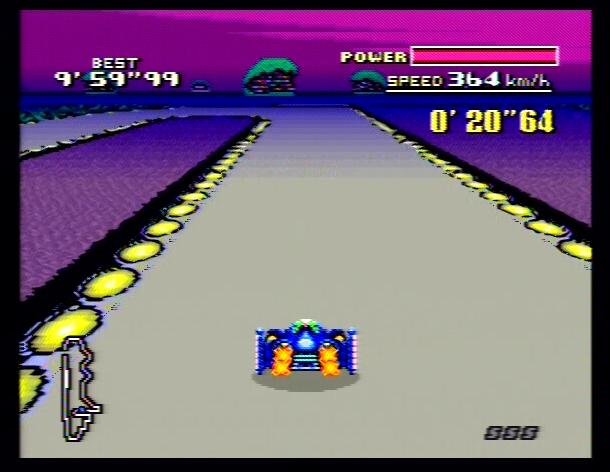 Marketing hype did not only affect video game related magazines. Journalist David Sheff, who authored Game Over in 1993, described most of the TurboGrafx game library as "not fun" or "unexceptional" to explain why the system's sales lagged behind competitors. Sheff also stated "the best entertainment-software companies were too busy making Nintendo games to bother making ones for TurboGrafx."6 Dismissing the early Genesis library as "sports games and arcade knockoffs," Sheff explained that Genesis developers created "great-looking games ... but not great-playing games."7 Sheff's analysis reflects the majoritarian view in the game industry from the late 1990s on, and is probably a result of his many developer and executive interviews rather than personal play time. Yet game reviews, and press coverage in general, were consistently more positive of the Genesis and TG16 than they were of Nintendo's NES from 1989 and 1990.
Marketing hype did not only affect video game related magazines. Journalist David Sheff, who authored Game Over in 1993, described most of the TurboGrafx game library as "not fun" or "unexceptional" to explain why the system's sales lagged behind competitors. Sheff also stated "the best entertainment-software companies were too busy making Nintendo games to bother making ones for TurboGrafx."6 Dismissing the early Genesis library as "sports games and arcade knockoffs," Sheff explained that Genesis developers created "great-looking games ... but not great-playing games."7 Sheff's analysis reflects the majoritarian view in the game industry from the late 1990s on, and is probably a result of his many developer and executive interviews rather than personal play time. Yet game reviews, and press coverage in general, were consistently more positive of the Genesis and TG16 than they were of Nintendo's NES from 1989 and 1990.
Emblazoned on the November 1989 cover of EGM was a close up screen image of Sega's award winning Ghouls n' Ghosts conversion for Genesis and a stamp reading "SEGA * SEGA: More Master System More Genesis." Steve Harris, Editor and Publisher of EGM, was pressured enough by readers to introduce his fourth issue excusing his magazine's tendency for Nintendo content.8 Harris also dedicated one fifth of his editorial to "owners of other machines" such as the TG16, and Atari systems. David White, an Associate Editor for EGM, maintained in the same issue that a "video game system is only as good as the games it plays" and asserted the TurboGrafx was the one system that stood above the crowd in this respect.9 In addition to reminding his audience of the ease of localizing successful PC-Engine titles to the TG16, White also began his Sega Genesis editorial with a full page about Sega Master System compatibility.10
Fall 1989 issues of Game Player's, a long running electronics magazine, dedicated dozens of pages to NES software and news, but had much to say about 16-bit consoles and their games. In a multi-page spread, Editor-In-Chief Tom Halfhill argued the merits of Sega's Altered Beast, which was a pack in game for the Genesis. Among his qualifications for "true arcade quality in your living room" Halfhill listed detailed and colorful screens that include multiple scroll layers, which he asserted "create an illusion of three dimensions." Smoothness and speed of character animation, "voice synthesis and stereo sound," and two player cooperative play were also listed as next-generation advantages due to "advanced computer chips inside the Genesis."11 Halfhill used similar terms when discussing the TurboGrafx CD-ROM add-on.12 Like EGM's David White though, Halfhill reasoned the merits of 16-bit gaming primarily in the context of game quality and reminded his audience that licensed games boosted console sales more than graphic and sound quality.13
Even in the new millennium, gameplay related comments on the Internet shine a dim light on at least three dozen worthwhile games released for the Genesis and nearly sixty for the TG16 by the end of their first full year.14 Among these games' developers were Data East, Hudson, Irem, Namco, NCS, and Victor for NEC's console and Asmik, Sunsoft, Electronic Arts, and Renovation for Genesis. Even without NEC and Sega's own offerings, these early third parties contributed greatly to the launch and first year libraries of both 16-bit consoles. Nintendo's NES had a monopoly on software developers and sales during these formative years, but exclusive and well received software was shared by all three of these game consoles.
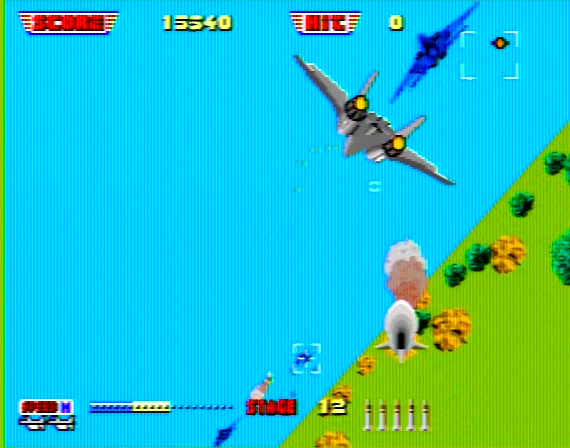 Gamepro accordingly progressed from its premier issue moniker "The Nintendo, Sega, and Atari Video Game Magazine," to include TurboGrafx, Genesis and Gameboy by the beginning of 1990. All game magazines were still subject to the dominant force in the industry. The majority of all game magazine advertisements in Gamepro and EGM during 1990 were for NES software, but majority rule affected EGM far more than Gamepro. EGM's Steve Harris contended, in summer of 1990, for his magazine's multi-platform objectivity even while he defended its position that the Genesis had proven itself "better" than the TurboGrafx-16.15 In the same issue that Harris argued EGM's judgments were exclusively about published games, EGM declared the still unnamed Super Nintendo "superior to anything that has every (sic) before been created." 16
Gamepro accordingly progressed from its premier issue moniker "The Nintendo, Sega, and Atari Video Game Magazine," to include TurboGrafx, Genesis and Gameboy by the beginning of 1990. All game magazines were still subject to the dominant force in the industry. The majority of all game magazine advertisements in Gamepro and EGM during 1990 were for NES software, but majority rule affected EGM far more than Gamepro. EGM's Steve Harris contended, in summer of 1990, for his magazine's multi-platform objectivity even while he defended its position that the Genesis had proven itself "better" than the TurboGrafx-16.15 In the same issue that Harris argued EGM's judgments were exclusively about published games, EGM declared the still unnamed Super Nintendo "superior to anything that has every (sic) before been created." 16
Nintendo's brand and largely incorrect hardware specifications was the only proof EGM needed of the SNES's preeminence. Harris' magazine listed the rarely used 512x448 interlaced resolution and 256 color modes for the SNES as though they would be used in the average game. A six page spread printed in EGM's December issue dubbed the Super Nintendo as "the ultimate in 16-Bit gaming" even before its Japanese launch.17 Gamepro, which had a special section every issue titled "The Cutting Edge," notably lacked any pre-launch editorials of the "ultimate" 16-bit console after its second issue back in 1989.
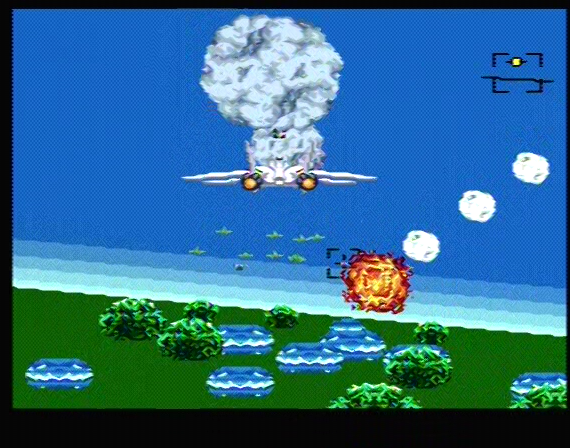 Notable hardware, like NEC's portable TurboGrafx-16 the Turbo Express, were given full attention by Gamepro but suffered attached editorials about the Super Nintendo in EGM.18 19 As a result of these two magazines' competing views all three console manufacturers received much needed free publicity. EGM reasonably presumed that the next Nintendo console would take over when it was eventually released. Gamepro, which apparently was not sending representatives to Japan at the time, represented a more impartial exposition of new games and hardware. Only the next year could tell what the American public actually wanted, but it was evident by the end of 1990 that Nintendo was losing its hold on the US game console industry.
Notable hardware, like NEC's portable TurboGrafx-16 the Turbo Express, were given full attention by Gamepro but suffered attached editorials about the Super Nintendo in EGM.18 19 As a result of these two magazines' competing views all three console manufacturers received much needed free publicity. EGM reasonably presumed that the next Nintendo console would take over when it was eventually released. Gamepro, which apparently was not sending representatives to Japan at the time, represented a more impartial exposition of new games and hardware. Only the next year could tell what the American public actually wanted, but it was evident by the end of 1990 that Nintendo was losing its hold on the US game console industry.
- 1. David Sheff, Game Over: How Nintendo Zapped an American Industry, Captured Your Dollars, and Enslaved Your Children (New York: Random House, 1993), 349.
- 2. Sheff, Game Over, 351.
- 3. Steven L. Kent, The Ultimate History of Video Games (New York: Three Rivers Press, 2001), 401.
- 4. Steve Harris, "The Amazing Super Nintendo," Electronic Gaming Monthly, August 1989, 39.
- 5. Steve Massey, "The Cutting Edge: Super Famicom. The Next Generation from Nintendo," Gamepro, July 1989, 13.
- 6. Sheff, Game Over, 351-52
- 7. Sheff, Game Over, 355
- 8. Steve Harris, "insert coin: You Asked For It, You Got It... More Sega!!!," Electronic Gaming Monthly, November 1989, 6.
- 9. David White, "Turbo Champ: TurboGrafx Explodes With Games!," Electronic Gaming Monthly, November 1989, 64.
- 10. David White, "Outpost: Genesis, The Master System Lives On!," Electronic Gaming Monthly, November 1989, 70.
- 11. Tom R. Halfhill, "Altered Beast: Arcade Action On The Genesis," Game Player's, October 1989, 42-44.
- 12. Halfhill, "NEC's TurboGrafx-16 CD: Plenty Of Potential," Game Player's, October 1989, 18-22.
- 13. Halfhill, "The EDITORS VIEW," Game Player's, November 1989, 4.
- 14. Notable Games: 1989-1990, http://www.gamepilgrimage.com.
- 15. Steve Harris, "The Genesis/Turbo Debate Concludes...," Electronic Gaming Monthly, July 1990, 6.
- 16. "Super Famicom Update ... 16-Bit Nintendo Close To Production!!," Electronic Gaming Monthly, July 1990, 29.
- 17. "Super Famicom Special," Electronic Gaming Monthly Presents the 1991 Video Game Buyer's Guide, December 1990, 28.
- 18. "The Whizz," "The Cutting Edge: The TurboExpress Handleld System," Gamepro, August 1990, 18.
- 19. NEC To Show Turbo Express at CES...First On-Hands Tests Reveal Superiority," Electronic Gaming Monthly, July 1990, 30.
1991: Hype vs Reality
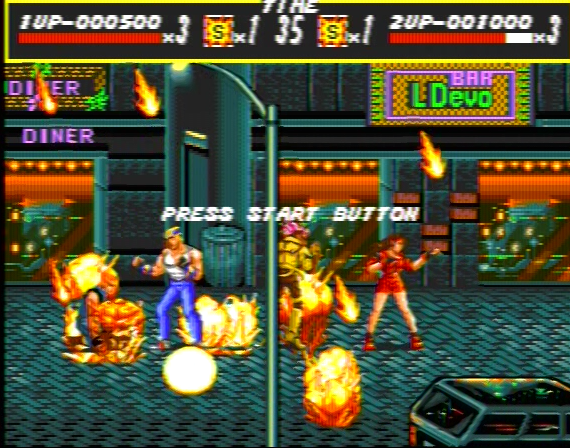 Not until March 1991 did issues of Gamepro and Game Players dedicate an editorial to the Super Nintendo. Unlike EGM's numerous articles comparing specifications provided by marketing departments, both Gamepro and Game Player's focused on the games that had already been released in Japan. Gamepro exhibited pictures of Super Mario World, F-Zero and Final Fight, while pointing squarely at the "massive support by third-party licensees" as the system's biggest advantage.1 Game Player's Tom Halfhill argued similarly that launch games for the Super Famicom, which was the console's final name in Japan, could have been made as well on the Genesis and TG16. Crassly dismissing exaggerated maximum color count and resolution differences for each system, Halfhill concluded "quality software and clever marketing are more likely to carry the day." 2 Marketing influenced more than the sales of these consoles or their games, it created the popular perception about the machines' capabilities and the quality of their libraries.
Not until March 1991 did issues of Gamepro and Game Players dedicate an editorial to the Super Nintendo. Unlike EGM's numerous articles comparing specifications provided by marketing departments, both Gamepro and Game Player's focused on the games that had already been released in Japan. Gamepro exhibited pictures of Super Mario World, F-Zero and Final Fight, while pointing squarely at the "massive support by third-party licensees" as the system's biggest advantage.1 Game Player's Tom Halfhill argued similarly that launch games for the Super Famicom, which was the console's final name in Japan, could have been made as well on the Genesis and TG16. Crassly dismissing exaggerated maximum color count and resolution differences for each system, Halfhill concluded "quality software and clever marketing are more likely to carry the day." 2 Marketing influenced more than the sales of these consoles or their games, it created the popular perception about the machines' capabilities and the quality of their libraries.
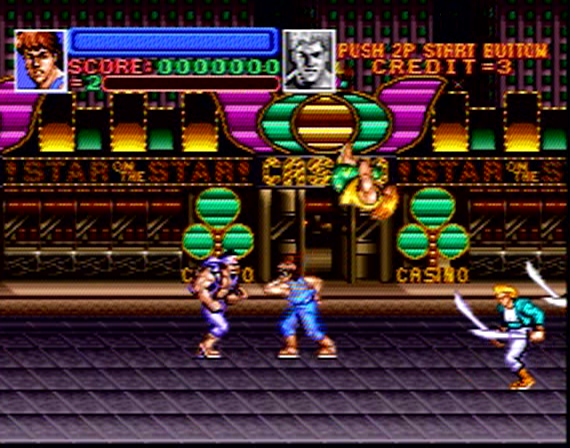 All game magazines that mentioned the Super Nintendo prior to its US launch noted something about its games displaying more colors on screen, but they disagreed on how significant the gap was. This disparity in journalist reviews was probably most influenced by the outputs and target of each of these system's graphics. TurboGrafx, Genesis and SNES consoles were packaged with RF cables intended for the coaxial cable input of an NTSC television, which was the standard in the US and Japan. Answering one Phil Kennington in the February 1991 issue, EGM ranked all available output cables for game consoles from RF, to Composite, and finally RGB. The editor also explained that EGM had to modify the hardware of all of their game consoles to support RGB monitors.
All game magazines that mentioned the Super Nintendo prior to its US launch noted something about its games displaying more colors on screen, but they disagreed on how significant the gap was. This disparity in journalist reviews was probably most influenced by the outputs and target of each of these system's graphics. TurboGrafx, Genesis and SNES consoles were packaged with RF cables intended for the coaxial cable input of an NTSC television, which was the standard in the US and Japan. Answering one Phil Kennington in the February 1991 issue, EGM ranked all available output cables for game consoles from RF, to Composite, and finally RGB. The editor also explained that EGM had to modify the hardware of all of their game consoles to support RGB monitors.
A consumer who wanted to view their console of choice with anything better than RF cables in 1991 had to buy a brand new television if they wanted to connect with AV Composite cables (Yellow video, with Red and White audio cables). Composite cables required an investment of twenty dollars in addition to a new television that would also improve cable and VCR quality. Obtaining a cable compatible with an RGB monitor required an investment of around one hundred dollars and a specialized monitor that cost significantly more than the new televisions being sold in electronics stores.3 EGM admitted that game companies targeted the lower quality outputs that the mass market could buy in stores, which severely impacted how many distinct colors could appear on the consumer's screens.4 Answering similar questions, Gamepro warned one Spanky Smith of Greensville South Carolina that Japanese RGB cables could have been incompatible with US equipment.5
Unencumbered by pertinent facts, EGM proceeded to advocate the "Super Famicom." Showing computer generated shots of three dimensional trees in a preview for Hole In One Golf, immediately following a four page promotion for Super Mario World, EGM explained "The Super Fami, with its large color palate(sic), can show shadings that give the illusion of 3-D." When Hal's Hole In One Golf was actually published that Fall it was notably absent of any three dimensional objects as shown in EGM's preview.6 Hole In One Golf actually does exhibit a unique feature of the Super Nintendo in the same manner of other launch titles. The SNES's Mode 7 allowed Hole in One Golf a fly by of a very low color two dimensional still image of the courses. Hole in One's courses were strictly overhead and two dimensional, with a special angled view that rendered the landscape in low detail to show elevation.7
During any generation of hardware, effects that the systems handled with the least programming effort are employed in games more often and more uniformly than effects that developers had to hand code. Mode 7 was marketed by Nintendo, and their allies, to become synonymous with real time scaling and rotation. Scaling is the term used for simulated zooming of backgrounds or characters, rotation allows the same to turn like a wheel. Mode 7 could only scale and rotate a single two dimensional background layer, no SNES game scales characters or objects in a Mode 7 scene. The effect was most often used to "jazz up" certain non-gaming scenes and racing games. Mode 7 offered nothing that was not technically already being done in similar scenes on other consoles, and was totally trumped by arcade machines from the late 1980s. The effect had a distinctive look, however, and its frequent use was the most obvious characteristic of Super Nintendo games. These facts gave Nintendo the ability to easily point out the look and sound of Super Nintendo games and made rumors about the system's technical superiority seem true.
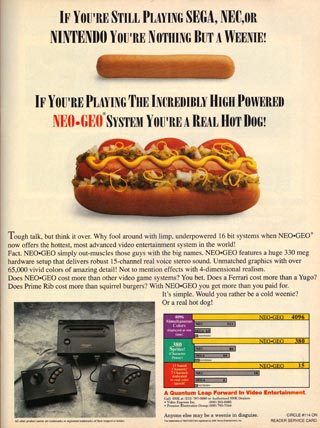 Introducing his April issue of EGM, Ed Semrad explained the importance of rumors to his readers and explained game magazines' function as free advertising for game companies. Semrad was also one of the first editors to print the term "vaporware" in regard to the Nintendo-Sony CD-ROM add-on for the affectionately abbreviated "Super Fami." 8 Even while Semrad lamented that "a very short nondescript press statement" tore the industry's attention from real consoles and games, the editor failed to note how similar that was to EGM's constant coverage of the SNES for the previous two years. In the previous issue's letter section, one T. Jones wrote that four different Nintendo representatives denied the accuracy of EGM's Super Famicom coverage so vehemently that their words were not fit for print. EGM responded that everything it had written about the SNES was correct regardless of the facts that the system name, its specifications and even the appearance of its games were significantly different in the final product.9
Introducing his April issue of EGM, Ed Semrad explained the importance of rumors to his readers and explained game magazines' function as free advertising for game companies. Semrad was also one of the first editors to print the term "vaporware" in regard to the Nintendo-Sony CD-ROM add-on for the affectionately abbreviated "Super Fami." 8 Even while Semrad lamented that "a very short nondescript press statement" tore the industry's attention from real consoles and games, the editor failed to note how similar that was to EGM's constant coverage of the SNES for the previous two years. In the previous issue's letter section, one T. Jones wrote that four different Nintendo representatives denied the accuracy of EGM's Super Famicom coverage so vehemently that their words were not fit for print. EGM responded that everything it had written about the SNES was correct regardless of the facts that the system name, its specifications and even the appearance of its games were significantly different in the final product.9
Hardware specifications in the game industry are only the product of marketing. It is evident from the published comments in all game related media that even the companies themselves were unsure of the technical limitations of their hardware. Advertising for the "consolized" NEO GEO arcade machine demonstrated the disparity between engineers and marketers very well. While SNK tried to convey that its arcade-machine-turned-console had "more" of everything, the TurboGrafx and Genesis specifications are reversed in two out of three categories.
Nintendo's public relations people out of Japan used similar terms to successfully, if inadvertently, convince EGM's publisher and editor to advertise the Super NES for several years in advance of its launch. As much as one million of the game industry's core demographic were exposed to EGM's Super Nintendo promotions every month. 10 By tossing out theoretical specifications without regard for television output, and knowing its audience did not have adequate programming knowledge of any system, Nintendo succeeded in establishing its upcoming console as "better" than anything else.
As a result of the Super Nintendo's preconceived superiority, the gaming media, retailers and public took an entirely different approach to Nintendo's second console than they did for the 16-bit consoles released two years prior. Instead of the usual skeptical "wait and see" consumer approach, the SNES might as well have already been a smashing success in all respects. The Genesis and TurboGrafx saw a couple of months of coverage prior to their US launch, which merely showed off the difference between their graphics and those of 8-bit consoles. The Super Nintendo, thanks largely to EGM, had seen monthly exposure for two years prior to its launch and enjoyed a full fledged buyer's guide in the August issues of Gamepro and EGM. Similar guides, that contained reviews, previews and pictures for every game announced for the US were finally published for the two existing 16-bit consoles the same year, which was two years after their US launch. Unfortunately for Nintendo, the hype failed to carry the NES' dominance into the new generation.
- 1. "The Unknown Gamer," "The Cutting Edge: Super Famicom Software," Gamepro, March 1991, 14.
- 2. Halfhill, "The Editor's View," Game Player's, March 1991, 4.
- 3. "Interface: Letters To The Editor, RGB For Genesis!..," Electronic Gaming Monthly, March 1991, 10.
- 4. "Interface: Letters To The Editor, SFX, too good for TV??..," Electronic Gaming Monthly, February 1991, 10.
- 5. "The Mail, Making the Connection," Gamepro, December 1991, 14.
- 6. "The Super Famicom Times: Hole In One Golf," Electronic Gaming Monthly, February 1991, 86.
- 7. "Fanatic Fan," "Overseas ProSpects," Gamepro, July 1991, 14.
- 8. Semrad, "insert coin: The Power of Rumors...," Electronic Gaming Monthly, April 1991, 8.
- 9. "Interface: Letters To The Editor, No SFX in US.," Electronic Gaming Monthly, March 1991, 10-11.
- 10. Semrad, "insert coin, 1,000,000 Readers!," Electronic Gaming Monthly, June 1991, 8.
1991: Part 2, Value Propositions
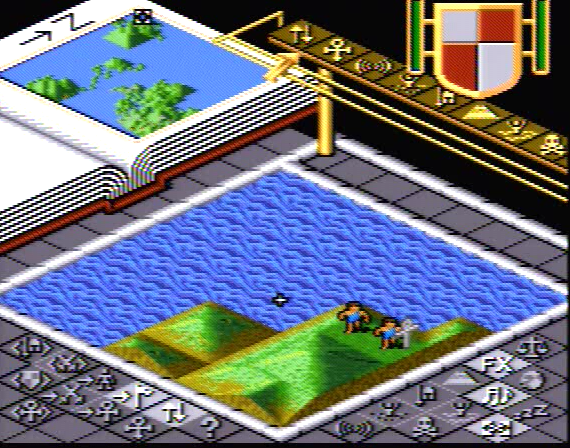 Gamepro referred to the SNES library as "fully three-quarters ... upgrades from 8-bit programs," even while it referred to Super Ghouls N Ghosts as a "new generation." 1 Previews of the SNES library over the next five pages were oddly broken up by advertisements, the first two of which featured Genesis games prominently along with their prices. Over thirty five SNES games were previewed in typical promotional fashion however and almost all of them are made by third parties that owners of Nintendo's first console recognized.
Gamepro referred to the SNES library as "fully three-quarters ... upgrades from 8-bit programs," even while it referred to Super Ghouls N Ghosts as a "new generation." 1 Previews of the SNES library over the next five pages were oddly broken up by advertisements, the first two of which featured Genesis games prominently along with their prices. Over thirty five SNES games were previewed in typical promotional fashion however and almost all of them are made by third parties that owners of Nintendo's first console recognized.
Never to be upstaged, EGM dedicated twelve pages to the SNES Buyer's Guide within their August 1991 issue, which posted review scores for sixteen games and previews for thirty four more. EGM's review system had four separate reviewers rank a game on a scale of one to ten. The SNES buyer's guide ranked three games with nines and eights, five games scored eights and sevens, and eight more were scored four through six. That is, half of the SNES games reviewable at launch came recommended by EGM's reviewers, and half were relegated to mediocre or worse.2
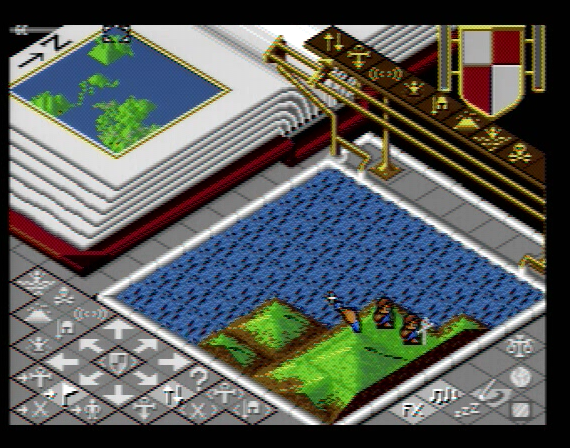 In addition to amassing a large game library for the Genesis, Sega had debuted two things that summer which stole these magazine's spotlights from Nintendo. Sonic the Hedgehog and the Mega CD-ROM add-on combined with one hundred and fifty nine other Genesis games were impossible for game magazines, and by reflection consumers, to ignore.3 Sega's CD add-on for the Genesis will be dealt with in more detail in its own section, but its show floor debut in summer of 1991, months from its Japanese release, lent Sega significant media coverage. Sega also managed to spend more on advertising than ever before, as EGM's October issue contained a 96 page promotion for everything that was licensed for release on the Genesis.4
In addition to amassing a large game library for the Genesis, Sega had debuted two things that summer which stole these magazine's spotlights from Nintendo. Sonic the Hedgehog and the Mega CD-ROM add-on combined with one hundred and fifty nine other Genesis games were impossible for game magazines, and by reflection consumers, to ignore.3 Sega's CD add-on for the Genesis will be dealt with in more detail in its own section, but its show floor debut in summer of 1991, months from its Japanese release, lent Sega significant media coverage. Sega also managed to spend more on advertising than ever before, as EGM's October issue contained a 96 page promotion for everything that was licensed for release on the Genesis.4
During the Christmas season of 1991 EGM and Gamepro printed reader letters and 16-bit buyer's guides 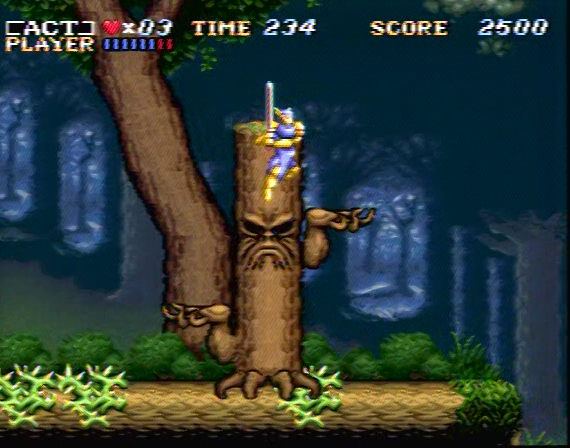 that defined the game industry as a three way race with Sega and Nintendo roughly equal in all respects. Reader letters showed a disparity rarely seen in the US game industry over which system carried absolute superiority. One William Miller of Lawndale California simplistically compared popular Genesis and SNES games, the two system's central processors, and included the Sega CD to conclude "the S-NES is totally lame." Meanwhile Brian McSwain of Sanford Florida felt that the Sega CD would merely bring the Genesis to equality with the SNES' "graphics, sound, play control and Mode 7." John Sikes of Detroit Lakes Minnesota assumed that most of the advantages that the Sega CD would provide were already offered by the TurboGrafx-16 CD-ROM attachment. EGM itself responded to Ron Ward of Newark California to point out that the Sega CD would have more RAM than the Turbo CD and would be more proficient at scaling and rotation than the SNES' Mode 7. Noah Freer of Los Angeles just wrote in to compliment Sega's 96 page advertisement in EGM's October issue.5
that defined the game industry as a three way race with Sega and Nintendo roughly equal in all respects. Reader letters showed a disparity rarely seen in the US game industry over which system carried absolute superiority. One William Miller of Lawndale California simplistically compared popular Genesis and SNES games, the two system's central processors, and included the Sega CD to conclude "the S-NES is totally lame." Meanwhile Brian McSwain of Sanford Florida felt that the Sega CD would merely bring the Genesis to equality with the SNES' "graphics, sound, play control and Mode 7." John Sikes of Detroit Lakes Minnesota assumed that most of the advantages that the Sega CD would provide were already offered by the TurboGrafx-16 CD-ROM attachment. EGM itself responded to Ron Ward of Newark California to point out that the Sega CD would have more RAM than the Turbo CD and would be more proficient at scaling and rotation than the SNES' Mode 7. Noah Freer of Los Angeles just wrote in to compliment Sega's 96 page advertisement in EGM's October issue.5
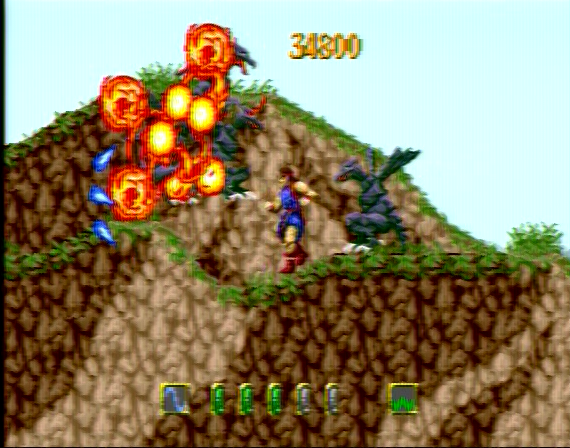 Despite the incongruity of comments EGM held nothing back in favor of the Super Nintendo. In EGM promotion speak the SNES was "unlike any other consumer game system," and it captured "the crisp color and detailed graphics that today's players are demanding." The magazine also listed the system's advantages as scaling, rotation and audio and its disadvantages as slowdown, flicker, and limited objects on screen.6 That objects on screen observation is particularly important, as the Super NES is supposed to have the strongest "sprite engine" of the three 16-bit consoles by a wide margin. Whether the cause be its slower CPU or poor programming, SNES games always struggle to put as many characters and objects on screen as top TG16 games. Genesis games handily beat both the TG16 and SNES libraries in the category of sprites on screen. In order for the SNES to live up to its prelaunch hype as a "16-bit Mega Monster" and the "Ultimate in 16-bit gaming" these deficiencies needed to be ironed out.
Despite the incongruity of comments EGM held nothing back in favor of the Super Nintendo. In EGM promotion speak the SNES was "unlike any other consumer game system," and it captured "the crisp color and detailed graphics that today's players are demanding." The magazine also listed the system's advantages as scaling, rotation and audio and its disadvantages as slowdown, flicker, and limited objects on screen.6 That objects on screen observation is particularly important, as the Super NES is supposed to have the strongest "sprite engine" of the three 16-bit consoles by a wide margin. Whether the cause be its slower CPU or poor programming, SNES games always struggle to put as many characters and objects on screen as top TG16 games. Genesis games handily beat both the TG16 and SNES libraries in the category of sprites on screen. In order for the SNES to live up to its prelaunch hype as a "16-bit Mega Monster" and the "Ultimate in 16-bit gaming" these deficiencies needed to be ironed out.
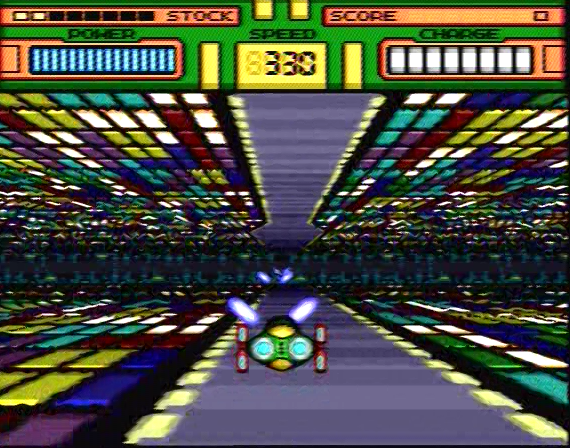 Instead of listing hardware specifications and eyeballing graphical glitches Gamepro listed the prices, described the game libraries and controllers, and forecasted what each system's library would be like in 1992. The Genesis was listed at $149 with Sonic The Hedgehog and one control pad, another controller brought the total cost to "only $30 less than a Super Nes." Sega's game library was described as "a terrific mix of licensed character games...sports simulations...arcade action carts...and Weird Funko-Dudes Lost in Outer Space." Game costs were $45-$60 although "8-megabit role playing games" were $75. Special note was given to the Power Base Converter, listed at $35, which allowed "backward compatibility with dozens of great 8-bit Master System titles." Wrapping up, Gamepro assured its readers that the next year would provide even more of the same qualities to the Genesis library, and numbered the total release list at one hundred and fifty nine.7
Instead of listing hardware specifications and eyeballing graphical glitches Gamepro listed the prices, described the game libraries and controllers, and forecasted what each system's library would be like in 1992. The Genesis was listed at $149 with Sonic The Hedgehog and one control pad, another controller brought the total cost to "only $30 less than a Super Nes." Sega's game library was described as "a terrific mix of licensed character games...sports simulations...arcade action carts...and Weird Funko-Dudes Lost in Outer Space." Game costs were $45-$60 although "8-megabit role playing games" were $75. Special note was given to the Power Base Converter, listed at $35, which allowed "backward compatibility with dozens of great 8-bit Master System titles." Wrapping up, Gamepro assured its readers that the next year would provide even more of the same qualities to the Genesis library, and numbered the total release list at one hundred and fifty nine.7
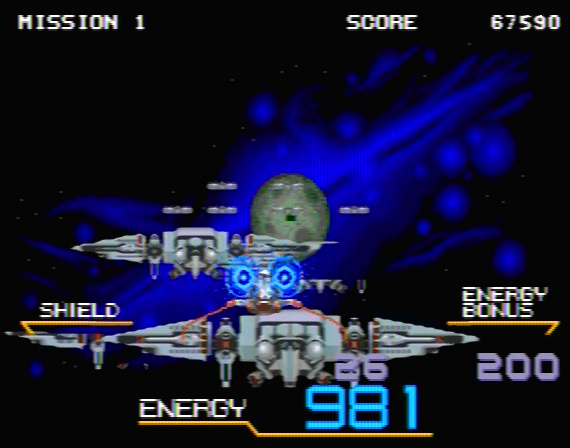 NEC's console was by contrast introduced with a zinger about its 8-bit CPU making it "less advanced" than the Genesis or SNES. The Turbo CD attachment was brought up only to mention that it was not selling well and that Sega and Nintendo would likely release something similar. The TurboGrafx retail package cost $99 with one controller and Keith Courage in Alpha Zones. To which Gamepro complained about why Keith Courage, released in 1989, had not been replaced with the $50 "Mario equivalent" Bonk's Adventure. Also of note is that the TurboGrafx required an expensive peripheral called the Turbo Booster or Turbo Booster Plus, $35 or $60 respectively, to hook up with newer televisions using Composite A/V cables. In addition, to play multiplayer games on the TG16 one had to purchase an extra controller at $20 and a TurboTap 5-Player Adapter at $20.8 Assuming that Gamepro was correct to compare the value proposition of each system, the Turbo Booster, TurboTap and an extra controller alone brought the total starting cost to the same as a Genesis with an extra gamepad. Adding any game from 1991 to the mix sent the total cost of the "entry level" TG16 over $200.9 Gamepro proceeded to trash the TG16's library as limited and quirky to US audiences, before explaining that it had "bottomed out" for players without the CD add-on. The Turbo CD itself was priced at $299 and its games cost between $19 and $62. The total library for the TurboGrafx-16 and the Turbo CD at the end of 1991 was reported to be sixty-seven "regular games" and fourteen CD games.10
NEC's console was by contrast introduced with a zinger about its 8-bit CPU making it "less advanced" than the Genesis or SNES. The Turbo CD attachment was brought up only to mention that it was not selling well and that Sega and Nintendo would likely release something similar. The TurboGrafx retail package cost $99 with one controller and Keith Courage in Alpha Zones. To which Gamepro complained about why Keith Courage, released in 1989, had not been replaced with the $50 "Mario equivalent" Bonk's Adventure. Also of note is that the TurboGrafx required an expensive peripheral called the Turbo Booster or Turbo Booster Plus, $35 or $60 respectively, to hook up with newer televisions using Composite A/V cables. In addition, to play multiplayer games on the TG16 one had to purchase an extra controller at $20 and a TurboTap 5-Player Adapter at $20.8 Assuming that Gamepro was correct to compare the value proposition of each system, the Turbo Booster, TurboTap and an extra controller alone brought the total starting cost to the same as a Genesis with an extra gamepad. Adding any game from 1991 to the mix sent the total cost of the "entry level" TG16 over $200.9 Gamepro proceeded to trash the TG16's library as limited and quirky to US audiences, before explaining that it had "bottomed out" for players without the CD add-on. The Turbo CD itself was priced at $299 and its games cost between $19 and $62. The total library for the TurboGrafx-16 and the Turbo CD at the end of 1991 was reported to be sixty-seven "regular games" and fourteen CD games.10
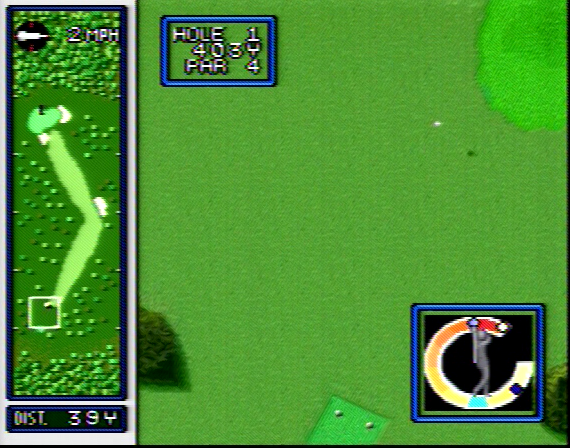 The Super Nintendo segment placed it at the "top-of-the-line price of $199.95," which included Super Mario World and two controllers. The Genesis and TG16 controllers were described in the previous sections, with the Genesis pad having a total of three "fire buttons" a start button and a directional pad and the TG16 pad being "the same as the NES." The SNES pad was conversely called "the most advanced anywhere" and potentially "too complex" for children. Nintendo's 16-bit library was presented as updates to NES games, with the cons being disappointing sequels and no NES compatibility. Gamepro's final analysis boiled down to "price, games, hardware power, and future expansion." The TurboGrafx was relegated to the "low end" inexpensive entry system with "psuedo 16-bit" shooters and multiplayer games. The TG16 was clearly excluded from Gamepro's consideration, which consumers had apparently already done, so the value proposition left only Nintendo and Sega products. The Genesis and SNES were portrayed as roughly equal in hardware capabilities, with the SNES' Mode 7, higher colors and "stronger sprite engine" being offset by being "only half the speed of the Genesis." In terms of library the Genesis was unequivocally found to have won by a landslide in 1991.11
The Super Nintendo segment placed it at the "top-of-the-line price of $199.95," which included Super Mario World and two controllers. The Genesis and TG16 controllers were described in the previous sections, with the Genesis pad having a total of three "fire buttons" a start button and a directional pad and the TG16 pad being "the same as the NES." The SNES pad was conversely called "the most advanced anywhere" and potentially "too complex" for children. Nintendo's 16-bit library was presented as updates to NES games, with the cons being disappointing sequels and no NES compatibility. Gamepro's final analysis boiled down to "price, games, hardware power, and future expansion." The TurboGrafx was relegated to the "low end" inexpensive entry system with "psuedo 16-bit" shooters and multiplayer games. The TG16 was clearly excluded from Gamepro's consideration, which consumers had apparently already done, so the value proposition left only Nintendo and Sega products. The Genesis and SNES were portrayed as roughly equal in hardware capabilities, with the SNES' Mode 7, higher colors and "stronger sprite engine" being offset by being "only half the speed of the Genesis." In terms of library the Genesis was unequivocally found to have won by a landslide in 1991.11
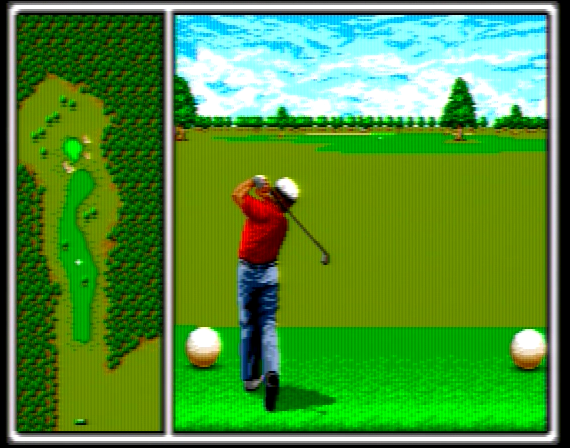 Much more prone to hyperbole, EGM asserted that "1991 saw the first real explosion of 16-bit interest, spurred largely by Nintendo and the long-awaited release of their Super Nintendo Entertainment System." Editor Ed Semrad also mentioned that price drops by both NEC and Sega and slowing NES game sales were defining characteristics of the year.12 Reducing thousands of letters each month to a few pages, EGM spent two columns of its December letter section over when the newly released Street Fighter 2 arcade game would be brought home to the Super NES.13 Street Fighter 2 is thought to have been responsible for revitalizing the arcade industry in the US, so its exclusive release on the SNES would have been very significant. Yet the battle for 16-bit supremacy was no longer one sided. D.J. Thomas of Houston Texas wrote EGM to ask which system and games won awards that year. EGM responded that it had released an entirely separate issue for the purpose of its annual awards stating "as to who won the best game of the year, and the best system of the year ... they're either Nintendo or Sega products."14
Much more prone to hyperbole, EGM asserted that "1991 saw the first real explosion of 16-bit interest, spurred largely by Nintendo and the long-awaited release of their Super Nintendo Entertainment System." Editor Ed Semrad also mentioned that price drops by both NEC and Sega and slowing NES game sales were defining characteristics of the year.12 Reducing thousands of letters each month to a few pages, EGM spent two columns of its December letter section over when the newly released Street Fighter 2 arcade game would be brought home to the Super NES.13 Street Fighter 2 is thought to have been responsible for revitalizing the arcade industry in the US, so its exclusive release on the SNES would have been very significant. Yet the battle for 16-bit supremacy was no longer one sided. D.J. Thomas of Houston Texas wrote EGM to ask which system and games won awards that year. EGM responded that it had released an entirely separate issue for the purpose of its annual awards stating "as to who won the best game of the year, and the best system of the year ... they're either Nintendo or Sega products."14
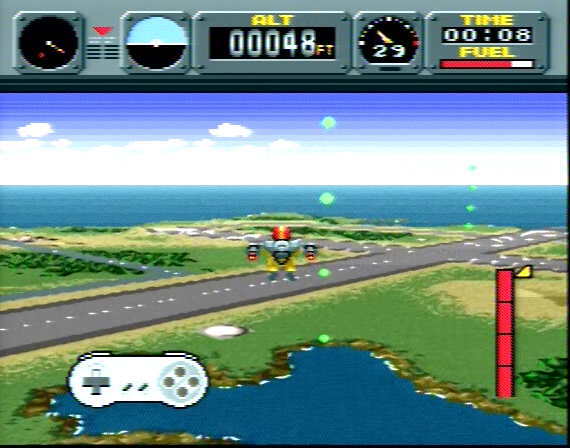 The SNES' primary weakness came up again as Doug Erickson of Chehalis Washington mused to EGM about why Nintendo went with a "slow processor" instead of a "80386 or 68000 series processor." Ignoring the ignorance over which x86 series processor was equivalent to the Genesis' CPU, Erickson's question is substantial for several reasons. Erickson's letter shows that EGM's readers had been bombarded by technical specifications enough to actually start questioning the engineering of a proprietary device as though they were qualified to do so. His assertion also shows that consumers in 1991 were comparing games across platforms and manufacturers. Nobody would have felt that the SNES was slow if they only compared it to Nintendo's NES. That is in contrast to what will happen in future generations where entire markets migrate to a new console without shopping other manufacturers' products. EGM revealed that "a lot of letters" like Erickson's were questioning Nintendo's engineering "wisdom," eliminating the likelihood that this letter was not representative of a typical consumer. The Japanese market's preference for slower moving Role Playing Games and that game developers would learn to better exploit the SNES' hardware were offered by EGM as alternative views to Erickson's and others.15 It should not be ignored, though, that this kind of exchange of generally negative comments would not have happened if Nintendo and its game advertising was still the dominant force in the industry.
The SNES' primary weakness came up again as Doug Erickson of Chehalis Washington mused to EGM about why Nintendo went with a "slow processor" instead of a "80386 or 68000 series processor." Ignoring the ignorance over which x86 series processor was equivalent to the Genesis' CPU, Erickson's question is substantial for several reasons. Erickson's letter shows that EGM's readers had been bombarded by technical specifications enough to actually start questioning the engineering of a proprietary device as though they were qualified to do so. His assertion also shows that consumers in 1991 were comparing games across platforms and manufacturers. Nobody would have felt that the SNES was slow if they only compared it to Nintendo's NES. That is in contrast to what will happen in future generations where entire markets migrate to a new console without shopping other manufacturers' products. EGM revealed that "a lot of letters" like Erickson's were questioning Nintendo's engineering "wisdom," eliminating the likelihood that this letter was not representative of a typical consumer. The Japanese market's preference for slower moving Role Playing Games and that game developers would learn to better exploit the SNES' hardware were offered by EGM as alternative views to Erickson's and others.15 It should not be ignored, though, that this kind of exchange of generally negative comments would not have happened if Nintendo and its game advertising was still the dominant force in the industry.
- 1. "Pizza X," "Super NES Made In Japan, The Raw and the Cooked: Pizza X at the Famicom Space World Show," Gamepro, August 1991, 26-27.
- 2. "Super NES Video Game Buyer's Guide," Electronic Gaming Monthly, August 1991, 59-72.
- 3. "Slasher Quan," "So You Want to Buy a 16-Bit System...," Gamepro, December 1991, 48.
- 4. Electronic Gaming Monthly, October 1991, 4.
- 5. "Interface: Letters to the editor, The Great Debate:..Super-NES vs Genesis vs Turbo," Electronic Gaming Monthly, 14.
- 6. "Super Nes Buyer's Guide, Insert Coin, Super 16-Bit Hardware! Super Charged Games! Super Nintendo!," Electronic Gaming Monthly, November 1991, 160.
- 7. "Slasher Quan," "So You Want to Buy a 16-Bit System...," Gamepro, December 1991, 48.
- 8. "Totally Turbo: The Total Source for TurboGrafx-16," Electronic Gaming Monthly, August 1991, 91.
- 9. "Slasher Quan," "So You Want to Buy a 16-Bit System...," Gamepro, December 1991, 49.
- 10. "Slasher Quan," "So You Want to Buy a 16-Bit System...," Gamepro, December 1991, 50.
- 11. "Slasher Quan," "So You Want to Buy a 16-Bit System...," Gamepro, December 1991, 50.
- 12. Ed Semrad, "insert coin: The EGM Difference," Electronic Gaming Monthly, December 1991, 8.
- 13. "Interface: Letters To The Editor, Street Fighter 2 for S-NES," Electronic Gaming Monthly, December 1991, 10.
- 14. "Interface: Letters To The Editor, 1992 Awards???," Electronic Gaming Monthly, December 1991, 12.
- 15. "Interface: Letters To The Editor, Slow S-NES," Electronic Gaming Monthly, December 1991, 12.
1992: Composite Market
At the beginning of 1992 it was clear that Sega had pulled a coup on Nintendo's highly anticipated launch. While Super Ghouls n Ghosts was referred to as a "new generation" in Gamepro's August 1991 issue, by February 1992 it was described as "basically an upgrade of the Genesis version" that suffers "from slow-down when there are multiple sprites on screen." 1 Even though Gamepro's description of two entirely different games is wildly inaccurate it does reflect a shift in public opinion based on the SNES' in game performance. As a result of popular perception and respective sales, longtime NES developer/publishers Acclaim and Gametek only signed on as Genesis licensees after Spring of 1992.2 Validating the fact that Sega's edge in game library, and Nintendo's concern over their own licensees turning multi-platform, Nintendo finally changed the annual limit of game releases for third parties from three to six.3 Nintendo also promised one hundred and fifty SNES games by the end of 1992, which was "a number equal to the current Sega Genesis library."4
EGM's Steve Harris admitted that the SNES' eventual introduction coincided with "other systems like the Sega Genesis" coming into their own. The same editor and publisher of EGM also revealed that Sega saw "sell outs across the board" during the critical Christmas season of 1991 and that Sega would enter the Winter Consumer Electronics show on top for the first time. Harris subsequently told his readers that both Sega and Nintendo would have to create greater quantity and quality of software to compete in 1992.5 Gamepro described retailer reports that the "Genesis outsold the Super NES often two to one over the Christmas season." Sega themselves cited a potential library of "more than 350 titles ... for the Genesis system by the end of 1992" as the reason why they would "hold more than 55% of the 16-Bit market."6 Perhaps in response, or due to the relatively low sales of TurboGrafx consoles, Namco announced that it would be releasing the sequel to Splatterhouse exclusively on the Genesis.7 BlockBuster Video, though, only reported the top ten 8-bit Nintendo rentals for the month, which indicates that they were still not carrying Genesis titles in all of their stores.8
Competition between hardware manufacturers created significant confusion. Trevor Paton of Nashville Tennessee misunderstood the SNES' highly publicized 32,768 color palette as the system's on screen capability. The reader subsequently called Genesis players to "give it up" and gloated that "all the great companies like Konami, Capcom and Acclaim" exclusively supported Nintendo. Mark Peters of Phoenix Arizona claimed that the SNES's actual game library made him forget its "overhyped specs" and Mode 7 capabilities to conclude that CD-ROM games were the real future. EGM responded to correct the SNES' on screen color limit and pointed out that Nintendo sales in 1991 had already caused an SNES price drop.9 By contrast Sega and NEC's 16-bit consoles were not discounted for over one year after their 1989 launch, which was during the NES' most dominant sales years.
Yet three quarters of a column on the same page were dedicated to readers requesting information on Nintendo's newest iteration of the Zelda franchise.10 Robert Sorensen of Cedar Park Texas excitedly asked whether popular NES games, or the announced Street Fighter 2 port to SNES, would be released on Genesis. Acclaim, Data East, Koei, and Vic Tokai were listed in response as new Sega licensees, but Capcom had not announced any intention of releasing games on "other" platforms.11 The SNES adaptation of the ultra violent arcade hit Smash TV meanwhile saw glowing reviews and was described as the "best home translation...on a video game system." RPM Racing, which is one of the only SNES games to use its "high resolution" mode was panned by EGM reviewers for using an isometric overhead view rather than utilizing Mode 7's pseudo three dimensional effect.12
Bullet Proof Software, Capcom, Electronic Arts, Konami, NEC, Renovation, Sega, Square Soft, and Tradewest were the only companies to win Gamepro's Readers Choice Awards.13 Answering Matt Wales of Rhinelander Wisconsin Gamepro stated that the rotation effect in Sonic the Hedgehog's bonus rounds was only technically different from the SNES' Mode 7 rotation because the SNES used a helper chip. In the same issue Winter Challenge, published by Accolade for the Genesis, was given a perfect graphics score for its excellent "scaling and rotation technologies."14 Matt Wales' question of whether this made the Genesis "equally capable" as the SNES shows how effectively marketed Mode 7 was regardless of whether it was a technically superior effect.15 Sonic the Hedgehog was given the "16-bit Game of The Year" award for its original character, graphics quality and game concept. Konami's Castlevania IV on Super Nintendo received the "Sound Achievement" award for exemplifying the "one area" the SNES "really makes an impression." Gamepro also admitted that the Sound award was the "closest race" and Castlevania IV only "edged out Actraiser [SNES] and ToeJam & Earl [Genesis]." 16
Coincidentally, Gamepro reported that the Genesis outsold the SNES in the 1991 Christmas season, citing unnamed retailers who "confirmed that the Genesis outsold the Super NES, often two to one, over the Christmas season." Sega pointed to a potential game library of "more than 350 titles ... for the Genesis system by the end of 1992" as the reason they would "hold more than 55% of the 16-bit market." 17 On the same page Block Buster Video's Top 10 NES Video Game Rentals indicated that the rental chain was still only carrying NES software in most stores.18 Namco nonetheless announced that it would be releasing Splatterhouse 2, the sequel to an earlier TurboGrafx and Arcade game, exclusively on the Genesis.19
Nintendo was the only console manufacturer with a substantial showing at the Winter Consumer Electronics Show (CES). According to EGM editor Ed Semrad, SNES licensees were doing "their homework as this new generation of carts have very little slow down or flicker." Teenage Mutant Ninja Turtles 4 (TMNT 4), Out of This World, Street Fighter 2, Super Battletoads, Contra 3, and Bart's Nightmare were all of the noted examples of such improved SNES software.20 Apparently SNES developers at CES relied heavily, if not exclusively, on sequels, arcade ports or licensed games to impress attendees. Accordingly, Sega's booth showing only drew remarks about its lack of sequels.
Semrad went on to describe why these games were so exemplary. Pointing to TMNT 4's effect of throwing enemies at the screen as "Mode 7," even though it is actually a simple three frame animation with no scaling, Semrad shows how obsessed EGM had become with the SNES's nuances. Out of this World was more objectively defined as a game with "extensive use of filled polygon graphics in a story book like adventure." 21 Nintendo apparently emphasized their SNES CD-ROM unit as having more RAM, better Full Motion Video, a special coprocessor and a cheaper price than NEC's or Sega's actual offerings. Semrad's account of NEC's display claimed "very impressive" titles being brought over from Japan, confirmation of the DUO and Super System Card's U.S. release, and a 32-bit console. Nintendo, according to Semrad, promised to sell six million SNES consoles in 1992, while not apparently limiting that number to just one region.
Answering Pablo Ayala of Acapulco Mexico, EGM reported "Nintendo has stated that they sold 2.1 million Super Nintendos in 4 months ... Sega states that they sold out their inventory and that their install base is nearly 2 million systems." 22 A full column on the same page was dedicated to "S-NES Street Fighter 2." EGM's editor claimed "hundreds of letters each week are pouring in..." for the SNES' "16 meg wonder." 23 EGM continued by promoting SNES Street Fighter II's accuracy to the Arcade original's gameplay. Conversely, the SNES adaptation of Turtles in Time drew more attention for being two player and that "there is no sign of flicker when the action gets intense." EGM also incorrectly attributed an effect in Turtles in Time that allows the player to throw enemy characters into the screen as "Mode 7" when it was in fact a simple three frame animation.24
One Gabe Pona of Hamilton, Ontario petitioned EGM for pictures and details of the new Battletoads game. EGM responded by saying "There are new super moves and, of course, it is a two player cooperative game..." and dedicated a "special preview fact-file" to the one level beta they played at CES. 25 Emphasizing revolutionary screen rotation, EGM also assured Paul Kravitz of Fortuna, California with a preview of Equinox, a Sony published game released in early 1993.26
Gamepro's March 1992 issue asserted "Nintendo of America jump-started the video game biz back in 1985 with the Nintendo Entertainment System. Over thirty million consoles and several billion dollars later, NOA launched the Super Nintendo Entertainment System last September." Gamepro interviewed Bill White, Director of Advertising and Public Relations over "stacks of 'gripe' mail" regarding 8-bit compatibility, slowdown and CD-ROM development. Referring to an NES adapter for the Super Nintendo as "inappropriate," White explained that the supplied RF cables for both consoles would allow them to be hooked up to the same television at the same time. Gamepro's introduction to the topic described NES owners as "mildly annoyed to furious" at the lack of backward compatibility in the SNES. Naming Gradius II and Final Fight as examples, Gamepro also pressed Nintendo's Public Relations about why "'slowdown' plagues many SNES games." White responded that the SNES' "four separate CPUs" could easily best the Genesis and blamed slowdown in SNES games on the quality of the programming.27
According to Steve Harris, Capcom was aware that millions of people were anticipating the 16-Megabit Street Fighter II SNES cartridge adaptation that represented just as big of a technological leap as CD-ROM. 2 MegaBytes, or 16-Megabits, of ROM made Street Fighter II for SNES incomparable to any prior Arcade conversion in Harris' estimation. Prior to Street Fighter II's home release the most critically acclaimed Arcade conversion was Sega's 8 Megabit adaptation of Capcom's Strider, half the size of Capcom's upcoming Street Fighter II conversion. Ballistic's Star Control for Sega Genesis was the largest cartridge ROM at the time at 12 Megabits. Harris continued "there have only been three other companies strongly committed to delivering new game formats to the market (a trend that doesn't seem to be changing much outside of CD-ROM)." 28
Rubin Alanis of McAllen Texas wrote to EGM to say "we gamers use your ratings to see what games to buy and what to avoid." 29 Alanis went on to ask why Spiderman and Stormlord for Genesis, released in 1991 and 1990 respectively, were never reviewed. EGM responded "there are a lot of bad games" and that "because our review crew is so honest some companies have stopped sending us review copies of their games."30 The editor went on to promote EGM's reviews with speculation about how their review scores affect game sales and how the reviewers each represent different genre preferences. Finally, EGM admitted that some games "do fall through the cracks" due to release dates or sheer volumes of games to be reviewed.31 Missed release dates failed to to cause any shortage of coverage for The Legend of Zelda: A Link to the Past, which received a full column dedicated to questions about its release date slipping by several months.
Jake Thompson of Louisville Kentucky wrote EGM of his appreciation for the improvements to the magazine over the years, but pointed out that the NEO GEO coverage was lacking. EGM replied that one page on NEO GEO game Soccer Brawl, which was tucked between Game Gear and Gameboy reviews, was superior coverage.32 Another column was dedicated simply to clarify which developers made popular shooter franchises Darius and Gradius, which would be Taito and Konami respectively. Following that was two columns bent on exploits and glitches in the Arcade version of Street Fighter II.33 Two columns were dedicated to EGM's international coverage, and how readers could "play games for a living," followed by arguments for and against the Mega CD's regional lock out. Street Fighter II Championship Edition rumors and more self promotion for having correspondents in Japanese trade shows took up the rest of the page.34
Reader letters about SNES Street Fighter II took up nearly one and two thirds columns in the May issue's "Interface: Letter's To The Editor," and the last quarter displayed positive reader letters about the SNES CD.35 On the next page Michael Andrejasik of Alberta Canada complained "I am sick of always hearing about the Sega Genesis. What about the Super NES. When Genesis first came out it hardly had any games and it was terrible."36 Andrejasik's letter was set on asking EGM to cover the SNES more, claiming that if they "give the S-NES a year or two" it would be the clear winner.37
Conversely Ronnie Boles of Winston-Salem North Carolina complained that some comments from EGM's March issue were too critical of Sega. Claiming that the magazine forecast better futures for Nintendo and NEC, Boles confessed "I do believe that the Mega CD will leave the rest in the dust."38 Boles went on to question why the SNES coverage was greater than Genesis coverage the previous month. EGM reminded its readers that Sega traditionally did not show much during the January CES, claiming "we ran pictures of everything that was there." 39
Gamepro's May 1992 issue opened up with a stark comparison of the Genesis and SNES game libraries in relation to Sega's recent Christmas sales victory:
"Retailers and gamers acknowledge that the biggest advantage Sega had over Nintendo in their recent 16-bit Christmas skirmish was a huge, diverse library of software - over 150 titles compared to 24 for the SNES."40
The rest of the article advocated better communication within the industry to ensure third parties could accurately predict how many games made in which genres would actually sell.41 So slim was the SNES library at that point that Gamepro considered it significant news that Innovation, a US based company, had apparently completed an adapter to play NES games on the Super NES. The adapter was dubbed "The Super Eight Converter," and was expected to be released in the Summer of 1992.42
Any such converter for playing NES games on the SNES would have to be an NES in a cartridge. The SNES' backwards compatibility was scrapped before its release and will never function like the adapters for Master System games on the Game Gear or Genesis, which rely mostly on compatible hardware in each base system. Following that, Gamepro found it fit to print that yet another long time NES third party licensee had "announced plans to develop software for the Sega Genesis in the second half of 1992," Software Toolworks.43
EGM's Steve Harris briefly described the Consumer Electronics Show (CES), in his June issue, as "the definitive showcase for everything new in video games." 44 CES provided over one hundred booths, the opportunity to play test new games, and the chance to take the first pictures of games that would be released later on. Summer CES of 1992 was apparently the first one to be opened to the public. "Hot hits like Street Fighter 2, Turtles 4, Batman Returns and Sonic 2," Harris opined, would be the prime attraction for "the game player."45 "Special screenings" for new hardware, including the Sega CD, GameBoy Game Genie, Sony Play Station and TTI's Turbo DUO were listed along side the promise of never before seen "softs and hardware previews".46 Harris also promised an EGM booth with free samples of the July issues, a Street Fighter 2 tournament with an Arcade machine and "Super NES carts as prizes."47 For those who could not attend the Summer CES, Harris promised a special 32-page collector's magazine that highlights everything video games have to offer in the months to come!"48
EGM printed a full page, three columns, on Street Fighter II in its June issue with only one negative letter in the bunch. Naturally the only letter available was from a Sega fan, John Mulin of Bayport New York, who petitioned EGM to "spend your time on other stuff like the Genesis not the S-NES." 49 EGM simply explained "we really had to sarch long and hard through the mailbag to find a negative letter like John's."50 A letter from one Michael Owens, of Walls, MS, represented the only positive published letter about the Genesis or its upcoming games. Owens was confident that Technosoft's "master pieces will be released in America," but wanted to know why Elemental Master had not been localized by then. EGM replied that Elemental Master was released in Japan at a time when "everybody was bringing out a new shooter and Technosoft just didn't think it would do very well in the U.S."51 Thunder Force 4 being "very new" while "still to (sic) early to tell if it is going to live up to the Thunder Force tradition" was the editor's only other comment before promoting EGM's Summer CES coverage again.52
- 1. "The Mail, School Me on Ghouls," Gamepro, February 1992, 12.
- 2. "PRO Report News, Acclaim Becomes Sega Licensee...Gametek Joins Sega Too," Gamepro, February 1992, 130.
- 3. "PRO Report News, Nintendo OK's More SNES Games," Gamepro, February 1992, 130.
- 4. "PRO Report News, Here Comes Super Famicom (SNES?) Software!," Gamepro, February 1992, 130.
- 5. Steve Harris, "insert coin, It's That Time of Year Again...," Electronic Gaming Monthly, February 1992, 10.
- 6. "Pro News Report, Genesis Scores A Big Xmas," Gamepro, March 1992, 90.
- 7. "Pro News Report, Splatterhouse Cuts into the Genesis," Gamepro, March 1992, 92.
- 8. "Pro News Report, BlockBuster Video Top 10 NES Video Game Rentals March 1992," Gamepro, March 1992, 90.
- 9. "Interface: Letters To The Editor, System Wars... Part 2," Electronic Gaming Monthly, February 1992, 14.
- 10. "Interface: Letters To The Editor, More Zelda 3...!," Electronic Gaming Monthly, February 1992, 14.
- 11. "Interface: Letters To The Editor, More Sega Licensees...!," Electronic Gaming Monthly, February 1992, 16.
- 12. "Review Crew," Electronic Gaming Monthly, February 1992, 20.
- 13. "The Gamepros," "The Forecast: A Good Year for Games," Gamepro, March 1992, 8.
- 14. "Genesis Pro Review," Gamepro, March 1992, 42.
- 15. "The Mail: Busy Getting Dizzy," Gamepro, March 1992, 10.
- 16. "Team Gamepro," "1991 Reader's Choice Awards," Gamepro, March 1992, 18.
- 17. "Pro Report News, Genesis Scores a Big Xmas," Gamepro, March 1992, 90.
- 18. "Block Buster Video: Top 10 NES Video Game Rentals March 1992," Gamepro, March 1992, 90.
- 19. "Pro Report News, Splatterhouse Cuts into the Genesis," Gamepro, March 1992, 92.
- 20. Ed Semrad, "insert coin, CES Impressions...," Electronic Gaming Monthly, March 1992, 8.
- 21. Ed Semrad, "insert coin, CES Impressions...," Electronic Gaming Monthly, March 1992, 8.
- 22. "Interface: Letters To The Editor, 16-Bit Wars..." Electronic Gaming Monthly, March 1992, 16.
- 23. "Interface: Letters To The Editor, S-NES Street Fighter 2," Electronic Gaming Monthly, March 1992, 16.
- 24. "Interface: Letters To The Editor, Turtles 4...?" Electronic Gaming Monthly, March 1992, 18.
- 25. "Interface: Letters To The Editor, Super Battletoads...?" Electronic Gaming Monthly, March 1992, 18.
- 26. "Interface: Letters To The Editor, Where is Solstice 2...?" Electronic Gaming Monthly, March 1992, 18.
- 27. "Nintendo Answers Your Questions," "The Gamepros," Gamepro, April 1992, 8.
- 28. Steve Harris, "Insert Coin, What Shape Will The Future Take?," Electronic Gaming Monthly, April 1992, 7.
- 29. "Interface: Letters To The Editor, 'Missing Reviews,'" Electronic Gaming Monthly, April 1992, 12.
- 30. "Interface: Letters To The Editor, 'Missing Reviews,'" Electronic Gaming Monthly, April 1992, 12.
- 31. "Interface: Letters To The Editor, 'Missing Reviews,'" Electronic Gaming Monthly, April 1992, 12.
- 32. "Interface: Letters To The Editor, 'More Neo-Geo,'" Electronic Gaming Monthly, April 1992, 16.
- 33. "Interface: Letters To The Editor, 'More Neo-Geo,'" Electronic Gaming Monthly, April 1992, 16.
- 34. "Interface: Letters To The Editor" Electronic Gaming Monthly, April 1992, 18.
- 35. "Interface: Letters To The Editor" Electronic Gaming Monthly, May 1992, 12.
- 36. "Interface: Letters To The Editor, 'Too Much Genesis Coverage,'" Electronic Gaming Monthly, May 1992, 16.
- 37. "Interface: Letters To The Editor, 'Too Much Genesis Coverage,'" Electronic Gaming Monthly, May 1992, 16.
- 38. "Interface: Letters To The Editor, 'Not Enough Genesis Coverage,'" Electronic Gaming Monthly, May 1992, 16.
- 39. "Interface: Letters To The Editor, 'Not Enough Genesis Coverage,'" Electronic Gaming Monthly, May 1992, 16.
- 40. "31 Flavors of Vanilla," "The Gamepros," Gamepro, May 1992, 4.
- 41. "31 Flavors of Vanilla," "The Gamepros," Gamepro, May 1992,4.
- 42. "Pro News Report, 'NES to SNES converter,'" Gamepro, May 1992, 98.
- 43. "Pro News Report, 'Software Toolworks Does the Genesis,'" Gamepro, May 1992, 98.
- 44. Steve Harris, "insert coin, 'Something Funny Happened On My Way To The Consumer Electronics Show...,'" Electronic Gaming Monthly, June 1992, 8.
- 45. Steve Harris, "insert coin, 'Something Funny Happened On My Way To The Consumer Electronics Show...,'" Electronic Gaming Monthly, June 1992, 8.
- 46. Steve Harris, "insert coin, 'Something Funny Happened On My Way To The Consumer Electronics Show...,'" Electronic Gaming Monthly, June 1992, 8.
- 47. Steve Harris, "insert coin, 'Something Funny Happened On My Way To The Consumer Electronics Show...,'" Electronic Gaming Monthly, June 1992, 8.
- 48. Steve Harris, "insert coin, 'Something Funny Happened On My Way To The Consumer Electronics Show...,'" Electronic Gaming Monthly, June 1992, 8.
- 49. "Interface: Letters To The Editor, 'Street Fighter 2 Feedback...,'" Electronic Gaming Monthly, June 1992, 12.
- 50. "Interface: Letters To The Editor, 'Street Fighter 2 Feedback...,'" Electronic Gaming Monthly, June 1992, 12.
- 51. "Interface: Letters To The Editor, 'Where Is?,'" Electronic Gaming Monthly, June 1992, 18.
- 52. "Interface: Letters To The Editor, 'Where Is?,'" Electronic Gaming Monthly, June 1992, 18.
Turbo DUO
| Lifespan: | 1992-1993 |
|---|---|
| CPU: | 7.16 MHz 8-bit HuC6280 3 |
| Audio: | 6 Channels (Uses CPU) 4 1 ADPCM Channel CD Audio |
| Co-Processors: | 3.58 Mhz PSG 5 Video Processor: 16-bit HuC6270 6 Color Processor: HuC6260 7 |
| Resolutions: | 256x256 || 320x256 8 |
| RAM | 8 KB |
| Video RAM: | 64 KB |
| CD RAM: | 256 KB (Super System Card 3.0) 2048 KB (2 MB Arcade Card) 9 |
| Colors On Screen: | 480 (60-90 Average, ~128 Max in games) 10 |
| Color Palette: | 512 ( 32 Palettes of 16 colors each) 11 |
| Sprite Max & Size: | 64 at 16x16, 16x32, 16x64, 32x16, 32x32, and 32x64 pixels 12 |
| Sprites per Scanline: | 16 13 |
| Background Planes: | 1 Layer (Dynamic Tiles and Sprites were used to create up to four scrolling layers) |
The Turbo CD add-on suffered in the US from a high retail price and a relatively small library of localized software. By 1992 the PC-Engine (Japanese TurboGrafx) and CD-ROM attachment had been combined into one stand alone console simply called DUO. By summer of 1991 the DUO was known to be a TG16 and CD-ROM combined. The original CD-ROM attachment was reputedly limited by the Turbo Grafx's 64KB of VRAM. Appropriately, the DUO also built in the Super System Card, which mainly upgraded the system's video RAM to 256KB and cost $65-90 on its own. A new compression method, that would multiply the amount of data stored in Turbo CD games to "hundreds of gigabits," was also rumored to be employed by the new generation of Turbo CD DUO games.14 The combination of the DUO, Super System Card and NEC's "New Interactive Display" compression method caused Electronic Gaming Monthly (EGM) to dub the Turbo CD as "the word in expandability."15 NEC's products and the press surrounding them demonstrate how important incremental upgrades to existing hardware were in the video game industry of the early nineties.
Readers of EGM in 1991 felt the newly released SNES and Sega's add-on to the Genesis, the Mega CD in Japan, mandated a response from NEC. Tim Bassinger of Boise Idaho asked what NEC would do to offset the technical superiority of these two systems and EGM considered the Super System Card and NEC's compression system to be adequate responses.16 NEC Japan's PC-Engine DUO, which incorporated the base system and CD-ROM add-on with the 256KB RAM upgrade, listed for $460 but had already been discounted to $330. The list price was in the same range as the Megadrive-Mega CD combo unit announced in the same segment, but the discounted price was extremely close to what the Sega CD would cost alone in the US. Yet NEC Japan was prone to releasing incremental upgrades and accessories only in Japan. As a result, NEC of America had to negotiate with its parent company for the rights to release the DUO. NEC Japan had already moved on to expensive revisions like the $770 PC-Engine Laptop.17
High level negotiations between international corporations and their regional subsidiaries were rarely reported on. CD-ROM based game media and incremental system upgrades were important enough for such a report, and seen by Gamepro as a corporate "rattling sabres" in the game industry. 18 During the same Winter Consumer Electronics Show that Sega avoided showing upcoming Sega CD titles for Hudson Soft and NEC Technologies announced its merger to create Turbo Technologies (TTI). TTI was a Los Angeles based company that designed to develop and market all TurboGrafx products and launch the Turbo DUO that August.19
Gamepro reported, in March of 1992, that the PC-Engine was still a "formidable Number 2" in Japan before praising Konami's "forward looking" CD game development facility.20 CD-ROM development was still an experimental format however. Emil Heidkamp, senior vice president of Konami's Consumer Division, admitted that the new facility was created because Konami wanted to begin "compact disk game development to see how the CD games would sell." According to Gamepro, Konami's Technical Facility in Kobe Japan was created to be dedicated to CD development and employed "top video game programmers and artists." 21 CD-ROM games were not just noticed in Japan, as the "Reader's Choice Awards" for 1991 gave Sherlock Holmes for Turbo CD the "Graphics Achievement" stamp for its live actors and the quality of its Full Motion Video (FMV).22
Mark Bray of Toronto Canada asked, in a letter to EGM, why NEC had not localized more PC-Engine CD-ROM games like Far East of Eden and the R-Type Complete CD. The Japanese library seemed "a much wider (and better) selection" to Bray, who had imported the Super System Card 3.0 and purchased a PC Engine Adapter. EGM reiterated Hudson's and TTI's US release of the Turbo DUO, and promised that Far East of Eden 2, Tengai Makyou II in Japan, would see a US localization.23 No US translations of the PC-Engine CD Tengai Makyou games were ultimately released.
Nintendo's restrictive licensing contract had lost its grip on third parties, so with a large library of Japanese games to localize TTI marketed the Turbo DUO against the Sega CD add-on for the Genesis.
Meanwhile, Sega's Genesis had already captured the public's attention to such a degree that even the Super Nintendo took years to catch up to it worldwide, and barely managed to do so in the US. As a result, the Turbo DUO was forgotten by the masses almost as soon as it was released, and yet it remains a hard-core and import gaming favorite. US localizations of PC-Engine CD games for the DUO were as slim as NEC had provided for the Turbo CD, but a large over seas library and the type and quality of titles released locally lent the PC-Engine and TurboGrafx a very important legacy.
The NEC PC-Engine is credited as the reason the Sega Megadrive (Genesis) failed to take hold in Japan. During the Megadrive's formative years following its release in 1988 the PC-Engine not only outsold it but garnered a larger software library. Dracula X: Rondo of Blood is among the PC-Engine's large library of games, and is the game that inspired the Playstation hit, Castlevania: Symphony of the Night.
Sale price for a Turbo DUO in 2005 ranged as high $400 new in box, $300 average, and importing a PC-Engine DUO cost over $150 with shipping. Meanwhile the NES and SNES could be had for $50, and the Genesis console and its games had been all but forgotten by the masses. While the TurboGrafx-16 and its add-on were utter marketing failures, they also are perhaps the greatest success story from a gaming perspective. Having been killed by the fickle and abstract rules of business and marketing, the Turbo systems maintain high demand and value with gamers regardless.
- 1. Jonathan J. Burtenshaw, ClassicGaming.com's Museum NEC TurboGrafx-16 (TG16) - 1989-1993 (archive.org February 1, 2008)
- 2. TurboGrafx-16/Duo FAQ - By John Yu, Last revised: 05/25/95 (archive.org May 14, 2007)
- 3. GAMESX.com Forums, Console Mods, RobIvy64 (e-mail) "TG-16/PCE overclocking success!" (archive.org May 1, 2008)
- 4. 6 Waveforms, 1 Frequency Modulated Channel leaves 4 Waveforms, 1 Waveform Channel can become White Noise, all channels can be programmed for sound samples. Paul Clifford (e-mail), PC Engine Programmable Sound Generator (psg.txt) (accessed February 18, 2010) available from http://www.plasma.demon.co.uk/pcengine/; internet.
- 5. Clifford, psg.txt $0802 - Fine frequency adjust
- 6. Emanuel Schleussinger, PC-Engine Video Display Controller Documentation (vdcdox.txt), (February 1998, accessed March 19, 2010) available from http://www.zophar.net/documents/pce.html; internet.
- 7. Paul Clifford (e-mail), PC Engine Video Colour Encoder (vce.txt)(accessed February 18, 2010) available from http://www.plasma.demon.co.uk/pcengine/; internet.
- 8. Typically only 216 horizontal lines are visible and are either 256 or 320 pixels wide, Schleussinger, (vdcdox.txt) 5. The Sprites in the VRAM.
- 9. Japan Only
- 10. Sixteen 15 Color palettes for the background, sixteen 15 Color Palettes for Sprites, Clifford, (vce.txt).
- 11. Clifford, (vce.txt).
- 12. Nimai Malle (e-mail), pce_doc Video Sprites (accessed March 20, 2010) available from http://emudocs.org/?page=PC%20Engine
- 13. Actual limit may be 8 due to 16 pixel wide sprites being aligned as 32 pixel sprites, Malle, pce_doc Video Sprites
- 14. "Electronic Gaming Express...New CD-ROM Drives Announced By NEC, Sony And Phillips," Electronic Gaming Monthly, August 1991, 38.
- 15. Turbo Champ, Electronic Gaming Monthly, September 1991, 68.
- 16. "Interface: Letters To The Editor, NEC NEWS...," Electronic Gaming Monthly, December 1991, 12.
- 17. "Electronic Gaming Express... NEC to Bring Out U.S. TurboGrafx DUO in Late 1992...?," Electronic Gaming Monthly, January 1992, 48.
- 18. "The Whizz," "Cutting Edge, The DUO Comes to America" Gamepro, 16.
- 19. "EGM Express NEC Merges with Hudson, Brings Turbo DUO to U.S.!!," Electronic Gaming Monthly, February 1992, 40.
- 20. "The Gamepros," "The Forecast: A Good Year for Games," Gamepro, March 1992, 8.
- 21. "Pro News Report," Gamepro, March 1992, 90.
- 22. "Team Gamepro," "1991 Reader's Choice Awards," Gamepro, March 1992, 20.
- 23. "Interface: Letters to the Editor, TurboGrafx DUO..." Electronic Gaming Monthly, March 1992, 16.
Sega CD
| Lifespan: | 1992-1995 |
|---|---|
| CPU: | 7.67 MHz 68000 |
| Sub-CPU: | 12.5 MHz 68000 |
| CPU Co-Processors: | 3.58 MHz Z80 (Audio) 3 Texas Instruments 76489 (PSG Audio): 4 Channels 4 Yamaha 2612 FM Audio:5 6 Channels:6 10 Audio Channels total VDP7 Hardware Shadow and Lighting 8 |
| Sub-CPU Co-Processors: | Ricoh RF5C68A Compatible: 8 Channel 12.5 MHz PCM Sound 9 Digital to Analog Converter10 Graphics Co-Processor: Scaling and Rotation: sprites and backgrounds11 |
| Resolutions: | 256x224, 320x224, 320x448 12 |
| CPU RAM: | 64 KB |
| Video RAM: | 64 KB |
| Sub-CPU RAM: | 768 KB13 |
| PCM RAM: | 64 KB |
| CD Cache: | 16 KB |
| Backup RAM: | 8 KB |
| Boot ROM: | 128 KB 14 |
| Colors On Screen: | 61 (30-75 in game, average 50) 15 16 |
| Color Palette: | 512 |
| Sprite Max & Size: | 80 sprites 17at: 8x8, 8x16, 8x24, 8x32 16x8, 16x16, 16x24, 16x32 24x8, 24x16, 24x24, 24x32 32x8, 32x16, 32x24, 32x32 18 |
| Sprites per Scanline: | 20 at 320x224, 16 at 256x224 19 |
| Background Planes: | 2 layers with 16 colors per 8x8 pixel tile20 VDP handles scrolling as single planes, independently scrolling 8 line rows, and independently scrolling lines.21 Each 8 line row can can be displayed over or under others. 22 |
The Sega CD's origins lay simply as an answer to the TurboGrafx CD-ROM attachment and Sega's own System 32 Arcade board. In 1990 Electronic Gaming Monthly (EGM) frequently speculated about what Sega and Nintendo's answer to the Turbo CD would be. Starting in February 1991 the rumors took on a new facet as EGM began forecasting a home version of Sega's 32-bit System 3223 arcade board as a counter to a rumored 32-bit machine from TurboGrafx manufacturer NEC.24 Game magazines' penchant for reporting future hardware and expansions for current consoles reveals public zeal for incremental upgrades in the early '90s.
Gaining the jump on its competition, Sega's CD-ROM attachment depended on an additional 12.5 MHz 68000 that invited EGM to question whether it was the rumored dual processor "GigaDrive."25 Slightly more cautious with its technological guesses, Gamepro also ran a special article about 32-bit systems from NEC and Sega. The two Sega systems previewed were supposedly based on Sega's System 32 but had dual 68000 processors instead of a single 32-bit CPU. The cheaper unit, according to Gamepro, cost around $800 and the high end $2000.
There was precedent for such expensive consoles in the form of the NEO GEO and CD-I. It is far more likely, though, that these feature rich systems were merely toyed with before the Japanese release of Sega's CD-ROM attachment, called Mega CD, that December. Interestingly, Gamepro reported one month before that development prototypes for the "MegaDrive/32" had already been shipped to mainstay developers Telenet, CSK, Sur De' Wave and Game Arts. Most of these were actually early developers for the Sega CD.26
The Sega CD hardware had not been finalized until just before its unveiling at the Tokyo Toy Show in June of 1991 and its thirty to forty licensees had not received development kits by Fall of 1991. To compensate, Sega encouraged Micronet and other developers to make their first Mega CD games, such as Heavy Nova, as an 8 Megabit, 1 Megabyte, Genesis game that could have cutscenes and CD audio added to the 600 Megabyte CD-ROM game later.27 At a critical first viewing, EGM and all of the Japanese media that were invited to see the Mega CD's bios screen, menu system and Heavy Nova gave the system "a unanimous 'thumbs up.'"
EGM reported that Micronet and Sega saw this presentation as a crucial moment for the Sega CD, and took the media's enthusiasm as a sign to proceed with the attachment's launch in December. Approval of the Sega CD by the media was also likely a pivotal moment that decided whether or not Sega would release a stand alone System 32 based console or continue to improve the Genesis with incremental upgrades.28
If anything can be gleaned from the rumors and speculations of journalists in 1991 it is that the Sega CD was not designed to compete against the Super NES. Nintendo and Sega considered CD-ROM games a separate platform, and NEC eventually focused most of its US releases on CD-ROM games. The most likely reason for their distinction is that CD-ROM games cost up to five times more to develop than cartridge games in 1991.29 The cost of additional development staff, voice actors and musicians coupled with the comparatively high retail price of the hardware segregated and limited the CD-ROM game market.30 Yet the format was thought to be significant enough that NEC had released its TG16 attachment in 1990.
Electronics giants Sony and Phillips scrambled to maintain their presence as a CD-ROM manufacturer for the Super Nintendo even after Nintendo had revealed that it was working with Phillips exclusively. Like Sega's Mega CD hardware, Sony emphasized CD-ROM access speed for their never-released SNES peripheral, but evidence that winter indicated that Sony had no intention of including additional graphics hardware.31 Phillips' already released CD-I contained even more RAM and ROM than the Sega CD, but the multi-media set-top box was far too costly to be considered a consumer level video game console.32
Universally dubbed "cutting edge," Sega's CD-ROM based Genesis add-on was covered in every monthly game magazine starting July of 1991. Prior to summer of 1991 Nintendo maintained a dominant presence in editorials about the Sega CD. EGM, for example, relegated the Sega CD to a sub column while giving several columns of speculation and an artists rendition to Nintendo's nonexistent CD-ROM.33 As Nintendo actually launched the Super NES in August of 1991 the Sega CD shared nearly equal space on the front cover of EGM. The excitement surrounding the Genesis CD-ROM add-on, though, was merely centered around its specifications.
EGM listed three times the "buffer," which should have been called RAM, than NEC's soon to be released 2 Megabit Turbo CD upgrade card. The Sega CD has 6 Megabits of RAM specially allocated for game data, which is twelve times the amount of the original Turbo CD's System Card. EGM also extolled the Sega CD's credentials as including a "custom high speed laser pickup," and an additional CPU that EGM guessed was half again more capable than the Genesis' CPU. Sega CD's "biaxial" scaling and rotation was also said to trump the SNES' single background two dimensional Mode 7.34
One Paul Daniels of Tampa Florida wrote in December of 1991 just to thank EGM for its monthly coverage of Sega's Mega CD, and compared the coverage positively to EGM's pre-launch Super Nintendo promotions.35 The same issue provided a summarized interview with Sega CD creator Tomio Takami, who's name is notably absent from David Sheff's Game Over or Steven Kent's Ultimate History of Video Games. Conjecture of industry heads are used by both authors to write briefly about the Sega CD's ultimate lack of commercial success. For Takami the situation was significantly more complex.
Sega originally sought a CD-ROM attachment for the Genesis that cost less than $150 and would not suffer load times every minute as first generation TurboGrafx CD games did. Takami was also charged to include additional processing ability in the Sega CD because scaling and rotation for sprites and backgrounds was a prominent effect in Sega's arcade games.36 The additional cost of the 68000 CPU, PCM audio processor, Graphics Co-Processor, 768KB of RAM, and 216KB of other types of cache and ROM elevated the launch price in Japan to $370. Marketing research in 1991, presumably conducted by Sega, suggested that "the majority of serious players" would see the additional features as worthwhile.37
The Sega CD was therefore designed for a market of early adopters and experienced game players, as opposed to cost conscious casual players seeking only the next best thing in cartridge gaming. Journalists charged with writing history on this topic consistently miss the likelihood that add-ons like the Sega CD and Turbo CD were never created in the hopes of achieving monumental success. NEC, Sega and several other hardware manufacturers were much more bent on staying on the technological edge in this generation than on achieving market dominance with any one console. The importance of this idea should not be understated.
Nintendo's approach carrying over from the NES days required that they spend as much money as possible putting their competition out of business. All other manufacturers at the time spent their money trying to stay in business and on top of the technology curve. Game developers, who depended on less than one dozen game releases per year, saw the Sega CD as significant enough. Third party licensees for the Sega CD progressed from twenty-seven by previous reports to forty interested parties by its Japanese launch that December.38
The end of 1991 was not only pivotal for the Sega CD, but for Sega as a whole. Sega's Genesis had outsold Nintendo's brand new 16-bit console and sold out nation wide.39 The Mega CD had coincidentally impressed all who had seen it even after its launch in Japan. Gamepro asserted in its January 1992 issue that the additional 68000 model CPU in the Sega CD "produces a 32-bit quality effect." So capable was the add-on, according to Gamepro, that Sega's 32-bit Rad Mobile and Power Drift, which ran on a Y board40 with three 68000 CPUs, could not only be ported but "enhanced with new courses and music." 41 The article also listed support from noted developers and publishers Game Arts, Renovation, Sierra, Tengen, and Wolfteam, along with unknowns Sur De' Wave and Victor Musical Industries.42 The fact that many of these developers were reputed to have been given development kits for a rumored "System 32 based" stand alone game console should not be missed. Neither should Sega's US launch of the Genesis with fewer licensees, just two years prior, be forgotten.
A rumored Genesis-Sega CD combo unit was predicted by EGM to retail for $450 due to its "second super-fast CPU, a state-of-the-art pickup arm to keep access times low, and the extra 6 megabits of memory." SNK's NEO GEO was by comparison still listed at $570 for the console alone.43 Due to the contemporaneous development of US multimedia studios and subsequent US game development delays, Sega CD games missed the Winter Consumer Electronics Show.44 Gamepro managed to list incorrect specifications for the Mega CD, including multiple new graphics chips that would increase onscreen characters and colors. Audio capabilities were also misrepresented, including "an 8 channel PCM sound generator [that] supplements the MegaDrive's 12-channel PCM generator.45 Speculation exemplified pre-launch Sega CD hype for the remainder of 1992 and consumer demand for impossibly powerful upgrades to the Genesis.
Answering Geoff Oster of Mesa Arizona, EGM used the significantly higher cost of development to justify CD-ROM titles retailing for the same price as 8 megabit cartridges.46 EGM described the Sega CD as "long awaited" and exciting as it introduced Sega's Director of Marketing Al Nilson. Nilson promised that Sega CD software would "clearly show people things that you can't do on a cartridge based system." 47 Specifications listed during this early preview emphasized the add-on's RAM, ROM and audio along with access time, Full Motion Video (FMV), CD plus Graphics compatibility, and its software control panel.48 Nilson compared Sega CD FMV to VHS and said the "bulk of the software for the U.S. market is being developed here in the U.S. Much of it is based on movies and TV shows utilizing footage that is very American in nature." Twenty nine world wide Sega CD developers were counted but not named in the same executive interview.49
Nilson also explained that Sega CD software was "way, way to (sic) early" to be talked about by Winter CES. The Sega-Multi-Media Studio was created "in house" for CD games that could not be made as cartridges. All four pages of EGM's expose' was broken up by NES and SNES game advertisements.50 Nintendo, in Sega's absence, showed an artist rendition of their Super NES CD-ROM while conveying that the add-on would have more RAM, better Full Motion Video, and faster load times while being half the price of the Sega CD. The attachment as described would have required a cartridge inserted into the SNES cart slot that included all of the RAM and ROM and the graphics co-processor. The article also claimed that Phillips was still working on a method to make the SNES CD-ROM support the high end CDI format while costing $200 total and potentially launching as early as September 1992.51
Nintendo's Director of Advertising and Marketing, Bill White, reiterated the SNES CD-ROM's superiority in performance and price in Gamepro's April 1992 issue. White described the SNES CD as being $200 with a special cartridge loaded coprocessor that would create "a quantum leap forward in software." SNES CD would provide, according to White, full motion video quality that would allow players to "control the outcome of the battle with the Sheriff of Nottingham" in Robin Hood: Prince of Theives.52
In reaction to speculation over which new formats would become dominant, EGM's Steve Harris reminisced: "not since early 1989 have there been so many new types of hardware on the horizon." 53 Citing the Mega CD, Nintendo CD, Sony's Play Station SNES add-on, Gameboy Color and an NES to SNES adapter, Harris claimed that many people perceived so much new hardware as a sign of the industry's vibrance. Harris denied any unilateral pronouncements of CD-ROM or any other format "in an automatic place of preeminence above the current cartridge format." 54
Two columns were dedicated to EGM's international coverage, and how readers could "play games for a living," followed by arguments for and against the Mega CD's regional lock out. Against region lock out was one Angel L. Quinones of Jersey City New Jersey, who claimed that Sega should spend more time translating Japanese games saying "the second an 'All My Children" CD/FRPG comes out I will melt down my Genesis and use the plastic as my new Gameboy Stand."55 Implicit in EGM's response and Quinones' argument is that Sega was blocking imports specifically to leave Japanese games in Japan, while releasing licensed television and movie based games instead. EGM responded that 90% of its readers were against region protection and inferred that Nintendo would handle regional software differently. The editor posited whether Nintendo should "do the same thing with their CD machine," despite the fact that cartridge based systems were already region specific.56
EGM's May issue opened up with an editorial by Ed Semrad dedicated to the advent of CD-ROM gaming.
"While it only seems like yesterday that we made the jump from 8 to 16 bit gaming, very soon, we will leap from 16 bit cartridge to 16 bit CD-ROM entertainment. It all begins at the Summer Consumer Electronics Show when Sega (and possibly Nintendo) will unveil this new generation of games. There is a problem though. While the technology is there ... the industry - the game designers and programmers, may not be ready yet."57
With that EGM again cast doubt on whether developers and programmers could make enough CD-ROM games to sell the systems into the Mass Market. Additional questions include the hardware price and time needed to develop "spectacular software," citing Sonic the Hedgehog's one and a half year development cycle. Even with these doubts listed Semrad admitted "there will be enough Wow! type CDs at [Summer CES] to build interest, but the Fall launch of the system will only have a couple of spectacular games." 58
In response to James Clar of Watertown Wisconsin, EGM explained that it had "devoted five pages to the Mega CD and its games. In this we literally ripped the system apart and described every little detail." 59 Again EGM felt the need to point out Sega's low-key presence at the previous Consumer Electronic Show, but added that an article on the Genesis CD combo called Wondermega was printed in the same issue.60 To Andre Antoine of Kingshill St. Croix the Mega CD would definitively conclude the argument over whether the Genesis or SNES was "best." Yet the reader questioned what the real price of the Sega CD and SNES CD would be. EGM admitted that the printed "cost figures were estimates." 61
Christopher Friedberg of Bensalem Friedberg asserted in EGM's June issue "Like many I am eager to purchase the long awaited Sega Mega CD-ROM machine. It'll wipe out the competition, no sweat."62 Brazen predictions aside, Friedberg actually wanted to know how the Mega CD was selling in Japan. The response was less than enthusiastic, EGM wrote flatly "without good games, the system's popularity declined." The promise of "the next generation of software" later on in 1992 lent EGM to claim "it is likely that the system's sales will pick up again." 63
EGM then dedicated nearly a full page, three and three fourth's columns, of letters and its own explanations to the Sega CD. One Nathan Maas from Brooklyn, New York, insisted that he was "very concerned about Sega, its games and the new Mega CD-ROM." Maas, perhaps sarcastically, wondered whether Sega still existed because EGM had not provided enough updates to satiate his curiosity. Bryron (Sp) Snyder of Spokane, Washington, complained to EGM "first you were bragging about ... Mega CD specs and now it seems that you are taking Nintendo's side. Are you a fair weather fan and side with whatever is newer and more newsworthy?" Naturally EGM published a third letter from a Ron Moore of El Paso Texas who only wanted to complement their coverage of the Mega CD and stand alone Wondermega. EGM assured its readers that they were just "as concerned about the future of Sega" and that the only limitation to what news they published was what was available from sources at press time. In the case of the Sega CD, EGM insisted that Sega of America had "cut off U.S. press" and so all of their information had to come from England and Japan, which was apparently co-editor Ed Semrad's job. From England EGM managed to glean that the western name of the Mega CD would, in fact, be the Sega CD. EGM's Japanese sources reported that the Sega CD would cost $299, which was unavoidably compared to Nintendo's promised SNES CD price point of $200, with three pack-in-disks to lessen the blow.64
While the reader letters section published questions and news about the newly dubbed Sega CD, the next CD-ROM related page that June was about the still unfinished SNES CD-ROM. EGM teased "the most important new fact" was that the coprocessor "in the S-NES CD-ROM System Cart will clock out at an unbelievable 21 Mhz." 65
Old history comments, to be updated:
The Sega CD was the most successful add on ever made by any company, selling at 2.5 Million in the US from 1992-1995(8). Incidentally, the Sega CD and its software was selling moderately well in 1993, until Nintendo turned in a video of the Genesis version of Mortal Kombat (Acclaim) and the Sega CD game Night Trap (Digital Pictures) to Senator Lieberman. Senator Joseph Lieberman(D) then lead a very public witch hunt against violent video games, and pointed at Sega as the primary designer of such games. Despite Sega responding by creating the video game ratings board that eventually turned into the ESRB that all games are rated by today, sales of Sega CD hardware and software virtually stopped, and Sega Genesis sales began a gradual decline immediately following the televised Senate hearings(8). By selling as well as it did, the Sega CD was also the first add-on or console to introduce the CD medium to the masses, in the United States in the form of a console.
Sega CD Model 1 cost $300, and if one purchased the 17 games listed above, the Sega CD hardware would have cost $17.64 per game. Since the CD-ROM games were all priced at $50 or less, the total cost was $67.64 per game. Many cartridge games, especially the SNES’s chipped games, cost $70 alone at original retail.
- 1. Sam Pettus, SegaBase Volume 4 - Sega CD / Mega CD, (accessed May 27, 2010) available from http://www.eidolons-inn.net/ (archive.org March 30, 2008).
- 2. Christian Schiller, Sega CD programming FAQ revision 0.15 (scdpfaq_015.txt), available from http://www.eidolons-inn.net/ (December 6, 1998, accessed on March 16, 2010).
- 3. Can write to VRAM
- 4. 3 tone generators and 1 white noise, "Nemesis," GENESIS Technical Overview 1.00, (accessed April 1, 2010), 119.
- 5. Frequency Modulation is synthesized audio like PSG but considerably more complex
- 6. Nemesis," GENESIS Technical Overview 1.00, 92.
- 7. Charles MacDonald, E-mail || Homepage, Sega Genesis VDP documentation Version 1.5f (genvdp.txt) $01 - Mode Set Register No. 2, (August 10, 2000, accessed March 11, 2010), available from http://emudocs.org/?page=Genesis; internet.
- 8. MacDonald, genvdp.txt, 16.) Shadow / Hilight mode.
- 9. Sample wavelength 32 KHz max, scdpfaq_015.txt, IV. Hardware information.
- 10. 16 bit D/A converter, 8x internal oversampling digital filter, PCM and CD sound mixing, Mixing with mixing terminal possible, , scdpfaq_015.txt, IV. Hardware information.
- 11. scdpfaq_015.txt, IV. Hardware information
- 12. Interlaced double resolution mode, used in Sonic 2 splitscreen 2-player.
- 13. 256KB Word RAM is accessible Simultaneously by the Genesis CPU. Four 128KB banks of RAM are exclusive to the Sub CPU. The Genesis CPU can halt the Sub CPU and gain access to all four 128KB banks of RAM. "Chilly Willy," "Comparison of 4th generation ("8/16-bit") system hardware," Sega-16.com, accessed July 19, 2012, http://www.sega-16.com/forum/showthread.php?18434-Comparison-of-4th-generation-(-quot-8-16-bit-quot-)-system-hardware&p=504645&viewfull=1#post504645.
- 14. CD game BIOS, cd player software, CD+G compatible, scdpfaq_015.txt, IV. Hardware information
- 15. four 15-color palettes plus one background color
- 16. Direct 9-bit RGB (512 colors) available at half horizontal resolution, 160x224 or 128x224 visible, "Oerg866," "Nemesis" and "Chilly Willy," "Direct Color Demo using DMA," SpritesMind.net, accessed March 1, 2013, http://gendev.spritesmind.net/forum/viewtopic.php?t=1203.
- 17. MacDonald, genvdp.txt, 15.) Sprites
- 18. "Nemesis," GENESIS Technical Overview 1.00, 13.
- 19. MacDonald, genvdp.txt, Sprite Drawing Limitations.
- 20. Each tile shares colors from four 15 color palettes between the background and sprite layers, MacDonald, genvdp.txt, $0B - Mode Set Register No. 3.
- 21. MacDonald, genvdp.txt, $0B - Mode Set Register No. 3.
- 22. Hardware function of the VDP, MacDonald, genvdp.txt, 14.) Priority.
- 23. Toby Broyad, "System 32 Hardware," (accessed May 29, 2010) available from http://www.system16.com/, (archive.org May 1, 2008).
- 24. "Interface: Letters To The Editor: 'Giga Drive?...'," Electronic Gaming Monthly, February 1991, 10.
- 25. "Mega CD demo disk," Electronic Gaming Monthly, September 1991, 38.
- 26. "The Wizz," "The Cutting Edge: 32-bit systems, MegaDrive/32 Sega," Gamepro, November 1991, 14.
- 27. "Behind The Screens At Micronet Of Japan 'The Making of Mega-CD Games' - Part 1," Electronic Gaming Monthly, November 1991, 37-44.
- 28. "Electronic Gaming Express...Sega and Micronet Give EGM Exclusive Look At The First Production Mega-CD-ROM and Games," Electronic Gaming Monthly, November 1991, 46.
- 29. Ed Semrad, "insert coin: The EGM Difference," Electronic Gaming Monthly, December 1991, 8.
- 30. "Behind The Screens At Sega Of Japan 'The Making of Mega-CD Games' - Part 2," Electronic Gaming Monthly, December 1991, 122.
- 31. "Electronic Gaming Express...Sony Unveils Play Station Technology At Interactive Electronics Show," Electronic Gaming Monthly, December 1991, 36.
- 32. "Electronic Gaming Express...Major Hardware Manufacturers Show New CD-I Compatible Machines," Electronic Gaming Monthly, December 1991, 38.
- 33. "Electronic Gaming Express...CD-ROM Upgrades for Super Famicom, Mega Drive, NEO-GEO, TurboGrafx-16 And Super NES Upgrades," Electronic Gaming Monthly, May 1991, 24.
- 34. "Electronic Gaming Express...Sega Of Japan Unveils Mega-CD At Tokyo Toy Show!," Electronic Gaming Monthly, August 1991, 36.
- 35. "Interface: Letters To The Editor," Electronic Gaming Monthly, December 1991, 10.
- 36. "Behind The Screens At Micronet Of Japan 'The Making of Mega-CD Games' - Part 2," Electronic Gaming Monthly, December 1991, 115.
- 37. "Behind The Screens At Micronet Of Japan 'The Making of Mega-CD Games' - Part 2," Electronic Gaming Monthly, December 1991, 122.
- 38. "Behind The Screens At Micronet Of Japan 'The Making of Mega-CD Games' - Part 2," Electronic Gaming Monthly, December 1991, 122.
- 39. Steve Harris, "insert coin: It's That Time of Year Again...," Electronic Gaming Monthly, January 1991, 8.
- 40. Toby Broyad, "Y Board Hardware," (accessed June 26, 2010) available from http://www.system16.com/, (archive.org February 17, 2008).
- 41. E.D. Beta, "The Cutting Edge: Flash! Genesis CD Update!," Gamepro, January 1992, 16.
- 42. E.D. Beta, "The Cutting Edge: Flash! Genesis CD Update!," Gamepro, January 1992, 18.
- 43. "Gametronix," Electronic Gaming Monthly, February 1992, 55.
- 44. "Electronic Gaming Express... Mega CD/MegaDrive Combo Unit in Final Stages of Development," Electronic Gaming Monthly, January 1992, 46.
- 45. "The Whizz," "Cutting Edge," Gamepro, February 1992, 14.
- 46. "Interface: Letters To The Editor, Lower Mega CD prices," Electronic Gaming Monthly, February 1992, 16.
- 47. "Genesis Mega-CD The First Hands-On Test of The U.S. System!!," Electronic Gaming Monthly, February 1992, 114.
- 48. "Genesis Mega-CD The First Hands-On Test of The U.S. System!!," Electronic Gaming Monthly, February 1992, 116.
- 49. "Genesis Mega-CD The First Hands-On Test of The U.S. System!!," Electronic Gaming Monthly, February 1992, 118.
- 50. "Genesis Mega-CD The First Hands-On Test of The U.S. System!!," Electronic Gaming Monthly, February 1992, 120.
- 51. "EGM Express, Nintendo Releases Specs on Super NES CD-ROM...!" Electronic Gaming Monthly, March 1992, 42.
- 52. "Nintendo Answers Your Questions," "The Gamepros," Gamepro, April 1992, 8.
- 53. Steve Harris, "Insert Coin, What Shape Will The Future Take?," Electronic Gaming Monthly, April 1992, 7.
- 54. Steve Harris, "Insert Coin, What Shape Will The Future Take?," Electronic Gaming Monthly, April 1992, 7.
- 55. "Interface: Letters To The Editor, Mega-CD Encryption Pro... And Con..." Electronic Gaming Monthly, April 1992, 18.
- 56. "Interface: Letters To The Editor, Mega-CD Encryption Pro... And Con..." Electronic Gaming Monthly, April 1992, 18.
- 57. Ed Semrad, "insert coin: CD-ROM, Is The Industry Ready For It?..." Electronic Gaming Monthly, May 1992, 8.
- 58. Ed Semrad, "insert coin: CD-ROM, Is The Industry Ready For It?..." Electronic Gaming Monthly, May 1992, 8.
- 59. "Interface: Letters To The Editor, 'More Mega CD..,'" Electronic Gaming Monthly, May 1992, 16.
- 60. "Interface: Letters To The Editor, 'More Mega CD..,'" Electronic Gaming Monthly, May 1992, 16.
- 61. "Interface: Letters To The Editor, 'Mega CD Too Expensive?...,'" Electronic Gaming Monthly, May 1992, 18.
- 62. "Interface: Letters To The Editor, 'Mega CD ... Popular?,'" Electronic Gaming Monthly, June 1992, 18.
- 63. "Interface: Letters To The Editor, 'Mega CD ... Popular?,'" Electronic Gaming Monthly, June 1992, 18.
- 64. "Interface: Letters To The Editor, 'Mega CD ROM Update,'" Electronic Gaming Monthly, June 1992, 20.
- 65. "EGM Express, First Look At Super Nintendo CD-ROM Schematic" Electronic Gaming Monthly, June 1992, 48.
Genesis 32X
| Lifespan: | 1994-1995 | |
|---|---|---|
| CPUs: | Two 23 MHz 32-bit RISC Hitachi SH-2s 3 |
|
| Co-Processors (Genesis): 4 | 7.67 MHz Motorola 68000 5 3.58 MHz Z80 6 Texas Instruments 76489 PSG Audio: 4 Channels 7 Yamaha 2612 FM Audio:8 6 Channels 9 10 Audio Channels plus SH-2 PWM or MOD Player VDP10 Tile and Sprite HW Engine, Four 15 Color Palettes of 9-bit Palette Hardware Shadow and Lighting 11 |
|
| RESOLUTION: | 320x224 | |
| RAM: | 256 KB Main RAM 12 Two 128KB Frame Buffers 13 Genesis and/or Sega CD RAM |
|
| POLYGONS: | 25,000 texture mapped per second 50,000 theoretical (box specs) |
|
| Colors On Screen: | 256 in Mode 1 & 3 32,768 in Mode 2 |
|
| Color Palette: | 32,768 | |
| Storage: | Cart 16 Mbits to 32 Mbits, or 1X CD-ROM | |
| Marketing performance: | 23 MIPS per SH-2 |
Screenshots
The only other Sega add on, the 32X, features twin 23Mhz SH-2's, making the Genesis 32X combined with the Sega CD from two years prior arguably more powerful than the much more expensive 3DO. The Genesis 32X alone is certainly more capable of high color 2D and 3D gaming in absolutely every respect to the SNES even with its on cartridge processors like the DSP or Super FX 1+2 chips that were used in games like Pilot Wings, Super Mario Kart, Star Fox, Yoshi's Island, Stunt Race FX and others.
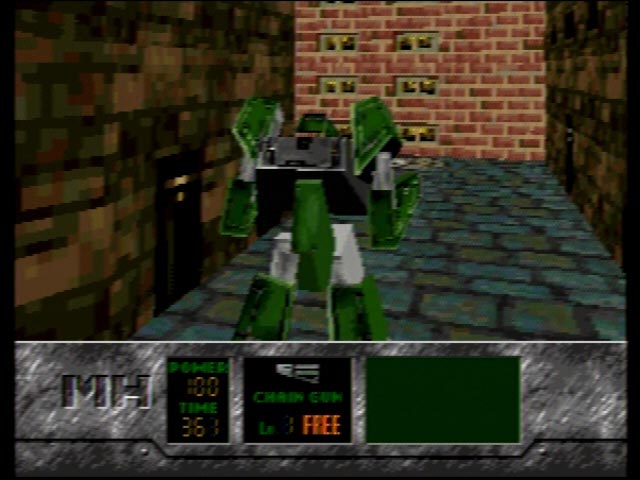 When the 32X add on launched the following months brought titles like Virtua Racing Deluxe, Shadow Squadron, T-Mek, the first near perfect arcade ports of Space Harrier and After Burner, NBA Jam, arguably the best home conversion of Mortal Kombat II, Knuckles Chaotix, Star Wars Arcade, and a good version of Doom from the PC. The total library added notable titles like Virtua Fighter, Kolibri, and a little over one dozen others in its 1 year life span. Despite its launch library being technically superior to what was available on 16-bit systems that Fall, the 32X sold less than 250,000 units total, with only 500,000 shipped to retailers in the first place.
When the 32X add on launched the following months brought titles like Virtua Racing Deluxe, Shadow Squadron, T-Mek, the first near perfect arcade ports of Space Harrier and After Burner, NBA Jam, arguably the best home conversion of Mortal Kombat II, Knuckles Chaotix, Star Wars Arcade, and a good version of Doom from the PC. The total library added notable titles like Virtua Fighter, Kolibri, and a little over one dozen others in its 1 year life span. Despite its launch library being technically superior to what was available on 16-bit systems that Fall, the 32X sold less than 250,000 units total, with only 500,000 shipped to retailers in the first place.
The 32X add on was actually an answer to public and media demand, but was rejected by the public first, arguably in favor of a single game on the SNES, Donkey Kong Country(9). Software developers then began canceling their announced projects. Konami canceled their highly anticipated port of the Turbo Duo version of Castlevania Rondo of Blood, and Capcom canceled a highly anticipated port of Super Street Fighter 2. Only after all 3rd party software developers had abandoned the 32X add on did Sega cease to manufacture and support it.
At this point Sega of Japan allegedly began to panic from declining Genesis sales world wide and the impending arrival of stand alone 3D game consoles. Sega of America's practice of overspending on marketing under Tom Kalinske, to overtake Nintendo's public mindshare, might have paid off if the Genesis were allowed to sell in to 1997. Less than 10 months after the 32X's release, Sega of Japan took over management and focused all resources on the Sega Saturn. Kalinske and his management team, who are regarded by media generated histories as being responsible for the Genesis' success in the States, subsequently resigned from their positions in Sega's American branch. This left Sega as a whole in financial debt and without a seasoned management team in America going into the next generation. Without the momentum of popular support from the Genesis to propel the Saturn into marketing success, or sufficient marketing dollars and experience in the US, Sega was ill prepared to defend its position not only against Nintendo, but against 3DO and Sony as well. Marketing dollars were, and are, particularly important in staving off harsh criticism from the video game media. An overview of Electronic Gaming Monthly and Gamepro from summer of 1994 through 1995 shows a concurrent decline of Sega related advertising and a steep increase in editorials that painted Sega in a negative light.
Regardless of public opinion of the add-on, the 32X was a cost effective and powerful expansion to the Genesis with more games available in its launch months than the Genesis or SNES enjoyed. One of the 150,000 people who bought a 32X at $160 might have also bought all twelve of the critically acclaimed games listed above and thus divided the cost of the add-on. Since 32X cartridges were all $50 each when they first launched, though they quickly dropped to less than $20 a game, each game would have cost $63.33 with the price of the 32X divided among them. That might seem like a lot for a game, but it is still less than the technically inferior SNES chipped games which were near $70 or more not including any hardware. With each additional purchase of a SNES FX chipped game the Super FX hardware was purchased again. So the actual cost per Super FX game would not go down as the library increased. Because the price per game did go down for 32X games, the argument for or against either format being a "rip off" could go either way. These facts failed to prevent gaming magazines from using the 32X to further sully Sega's reputation just prior to the launch of the Sega Saturn and Sony Playstation.
- 1. http://www.eidolons-inn.net/segabase/SegaBase-32X.html
- 2. Dr. DevSter's Guide to The Sega 32x, ">>ALMOST<< Everything you wanted to know, that you never knew, and that you're going to know about the 32x" Joseph Norman - pimp, http://devster.monkeeh.com
- 3. Speed rating is a multiple of the Genesis CPU. One SH-2 can be dedicated to PWM or MOD Audio Playback. SH-2s can be used as Master/Slave, with the Slave only processing main code when the Master is working or stalled.
- 4. Sega CD Sub-CPU, Graphics Co Processor and Ricoh Audio chip are not listed here due to their lack of use in 32X CD games.
- 5. Frequently used as an Audio driver and/or for game logic. 68K DAC playback works better in 32X software than i nGenesis games due to less need for the CPU being dedicated only to Audio.
- 6. Typically used for Audio. Can write to VRAM
- 7. 3 tone generators and 1 white noise, "Nemesis," GENESIS Technical Overview 1.00, (accessed April 1, 2010), 119.
- 8. Frequency Modulation is synthesized audio like PSG but considerably more complex
- 9. Nemesis,"GENESIS Technical Overview 1.00, 92.
- 10. Charles MacDonald, E-mail || Homepage, Sega Genesis VDP documentation Version 1.5f (genvdp.txt) $01 - Mode Set Register No. 2, (August 10, 2000, accessed March 11, 2010), available from http://emudocs.org/?page=Genesis; internet
- 11. MacDonald, genvdp.txt, 16.) Shadow / Hilight mode.
- 12. 16-bit bus, hard wired for "burst" mode.
- 13. Enough for double buffered 320x204 resolution frame buffer 15-bit color.
